Not everyone is equal in the kingdom of languages. There is one group that is mercilessly oppressed — one group which suffers from a


Nootropics are certainly one of those things that capture your imagination. You pop a pill and everything becomes clear. You are more vigilant, more observant.
Sure, three months down the road you start resembling a patient with a full-blown neurological disorder. You catch yourself scratching your arms nervously while your eyes twitch.
And if your pill is nowhere to be found you drop on the floor and start rhythmically convulsing.
But hey man! Those moments of clarity!
In all seriousness - nootropics have definitely become a thing in the last couple of years. The appeal is understandable.
At the price of a pack of pills, you can become a better version of yourself.
Is it really the case? Nope.
If you ask me, it's definitely more of a fantasy for the naive. Let me explain step-by-step why it is so and what you can do instead to become this sexy learning-machine.
Not everyone is familiar with this notion. Since I don't want to risk keeping you in the dark, let's delve into it.
Nootropics are natural and synthetic compounds that can improve your general cognitive abilities, such as memory, attention, focus, and motivation.
As a rule of thumb, natural nootropics are much safer and can actually improve the brain's health (see Suliman et al. 2016).
As you can see the definition is very far from being precise.
Let's suppose you go into the panic mode before an important meeting and your colleague bitch-slaps you. You suddenly become more focused and sharper.
Can this backhander be treated as a nootropic?
Once again, the definition is unclear. What is clear is that, even though you might not realize it, you probably take some of them already.
Our civilization can pride itself on having a long, rich history of drugging ourselves to feel better and smarter. Here are some of the weapons of the mass enlightening:
If your head bobs like a crazy pigeon if you don't get your daily fix, you are probably not surprised to see it here.
These days, it can be found almost everywhere. Especially in soft drinks, dark chocolate and, of course, in coffee.
Effects:
At normal doses, caffeine has variable effects on learning and memory, but it generally improves reaction time, wakefulness, concentration, and motor coordination. - Nehlig A (2010). "Is caffeine a cognitive enhancer?". Journal of Alzheimer's Disease.
L-Theanine, or simply theanine, can generally be found in tea.
The amount is dependent on the kind you drink but generally, you can get more in black tea than in green tea.
Effects:
Increases BDNF and attenuates cortisol-to-DHEAS, also has low affinity for AMPA, kainate, and NMDA receptors.
Great news for any enthusiast of Indian cuisine.
Effect:
Produces neuroprotective effects via activating BDNF/TrkB-dependent MAPK and PI-3K cascades in rodent cortical neurons.
Elevates BDNF by inhibition of GSK-3, which also increases skeletal muscle growth.
One of the most famous herbs which can boast such effects.
Effects:
Improved memory, enhanced focus/attention (similar to caffeine), enhanced mood through reduced anxiety, enhanced performance: reaction time, endurance, memory retention.
I know that you probably want to learn more about "real" nootropics. Here is a short list of some of them.
Effects:
Enhanced brain metabolism, better communication between the right and left brain hemispheres
Effects:
Offers neuroprotection via stimulation of PKC phosphorylation; upregulation of PKCepsilon mRNA; induction of Bcl-X(L), Bcl-w, and BDNF mRNAs; and downregulation of PKCgamma, Bad, and Bax mRNAs.
Effects:
An antioxidant that also stimulates NGF. Found to be a potent enhancer for the regeneration of peripheral nerves.
Effects:
Elevates NGF, BDNF, and GDNF.
Effects:
Stimulates NGF
Effects:
Elevates BDNF by inhibition of GSK-3, which also increases skeletal muscle growth.
Elevation of brain magnesium increased NMDA receptors (NMDARs) signaling, BDNF expression, density of presynaptic puncta, and synaptic plasticity in the prefrontal cortex.
The list goes on and on. As exciting as it all sounds, I would advise against taking most of them. Especially the ones which are intended for the patients with neurological disorders.

If you take caffeine in any form, it might be more than enough for you. Last year, a famous study compared the effectiveness of the CAF+ nootropic to caffeine.
The CAF+ contains a combination of ingredients that have separately shown to boost cognitive performance, including caffeine, l-theanine, vinpocetine, l-tyrosine, and vitamin B6/B12.
It was supposed to be the next big thing in the world of nootropics. Alas, it turned out to be a flop.
Here is the conclusion:
We found that after 90 min, the delayed recall performance on the VLT after caffeine was better than after CAF+ treatment.
Further, caffeine, but not CAF+, improved the performance in a working memory task. In a complex choice reaction task caffeine improved the speed of responding.
Subjective alertness was increased as a result of CAF+ at 30 min after administration. Only caffeine increased diastolic blood pressure.
We conclude that in healthy young students, caffeine improves memory performance and sensorimotor speed, whereas CAF+ does not affect the cognitive performance at the dose tested.
And that's exactly my point. A lot of those compounds which are being plugged shamelessly by different fancy-sounding brain websites are close to useless.
It's not uncommon to find comments on a Reddit about Nootropics saying that:
"500$ for nootropics is not that much. This is just the price of admission for finding the one which is right for you."
It doesn't sound alarming at all. No sir. Don't think of yourself as a cowardly version of a heroin addict. You're a brave brain-explorer! On a more serious note - a lot of these nootropics are not only shady but expensive as well. Keep that in mind, if you decide to try them out.
Even though natural nootropics are potentially safe, or even very safe, it definitely can't be said about synthetic nootropics. By taking them you automatically volunteer to become a guinea pig.
Many of the nootropics change your levels of neurotransmitters such as dopamine, serotonin, GABA and many others.
The thing is that so do many drugs like cocaine.
The long-term effect is usually a strong imbalance of transmitter levels in order to compensate those extremes.
It reminds a lot of enthusiasts of brain-zapping couple of years ago. Even though there were almost no double-blind studies confirming its effectiveness, people glibly jumped on this bandwagon.
Of course, you didn't have to wait long for the first papers showing that brain-zapping might not be as great as we once thought.
As Barbara Sahakian and Sharon Morein-Zamir explain in the journal Nature, we don’t know how extended use might change your brain chemistry in the long run.
Call me old-fashioned but if somebody needs a pill every time they want to feel smart or sharp, maybe they are not that smart or sharp? After every use, it's time for a cold and lonely wake-up call.
The important question to ask here is:
what kind of people would like to take such pills in the first place?
There are two groups:
These are people who have probably never put effort into any of the things they have been doing in their life. I know that you're not one of them because you can read. That takes us to the second group.
You know much, you've achieved much but you want more. That's great. That's admirable.
But as a high-achiever, you know that there is no such thing as a lunch for free. Things which are worth your time come with a price.
There are a lot of better, and more permanent, solutions to becoming a person with an extraordinary mind.
Your short-term memory is the bottleneck of your ability to acquire knowledge. By improving it, you can greatly accelerate your learning rate.
Mnemonics are definitely one of the best ways to do it. Read more about improving your short-term memory here.
If you eat like crap (e.g. a lot of processed foods) and you look at a cucumber as if it touched you in your childhood, you should definitely take care of this problem.
If you have problems with brain fog, concentration, and mental sharpness, there is a very good chance that your diet caused a lot of deficiencies. No nootropics will fix that for you.
Get your blood checked to see what minerals and vitamins you're lacking.
Not sure if you lack anything? Check your nails.
Healthy nails should be smooth and have consistent (pinkish) coloring.
Any spots, discoloration and so on should be alarming.
What's more, most of the time, you can basically assume that you lack Vitamin D3. Especially if you have an office job or don't live in a sunny climate. You probably also lack magnesium unless you're a health buff.
More sport and more physical interactions with people. Both these things will give you a nice dopamine and serotonin kick. If you suspect that nobody loves you, try hugging stray dogs. Even this will do.
Call me biased but no pill will substitute this kind of knowledge. Let's assume that you want to learn a language and you gobbled up a magical tablet. If you use bad learning strategies, you will still get nowhere. This time, however, a little bit faster than before.
Knowing how to learn is a permanent power.
If you don't know how to prioritize, nootropics will only make you browse all the cat pictures faster. Here is a good place to start.
Doing something all the time is definitely one of the worst learning strategies ever. Breaks and a good night sleep are a part of the job.
I should know. I consistently ignore and rediscover this piece of advice.
There are dozens of mental models and biases which invisibly shape the decisions you make. Get to know them in order to reason more efficiently.
This is probably the best piece of advice I can offer anyone. You need a lot of facts in order to think efficiently and recognize patterns.
Their accumulation won't happen overnight. It can be most aptly explained by one of my all-time favorite anecdotes.
Knowledge builds on knowledge; one is not learning independent bits of trivia.
Richard Hamming recalls in You and Your Research:
You observe that most great scientists have tremendous drive. I worked for ten years with John Tukey at Bell Labs. He had tremendous drive.
One day about three or four years after I joined, I discovered that John Tukey was slightly younger than I was. John was a genius and I clearly was not.
Well, I went storming into Bode’s office and said, How can anybody my age know as much as John Tukey does?
He leaned back in his chair, put his hands behind his head, grinned slightly, and said,
You would be surprised Hamming, how much you would know if you worked as hard as he did that many years. I simply slunk out of the office!
What Bode was saying was this: Knowledge and productivity are like compound interest.
Given two people of approximately the same ability and one person who works 10% more than the other, the latter will more than twice outproduce the former.
The more you know, the more you learn; the more you learn, the more you can do; the more you can do, the more the opportunity - it is very much like compound interest.
I don’t want to give you a rate, but it is a very high rate.
Given two people with exactly the same ability, the one person who manages day in and day out to get in one more hour of thinking will be tremendously more productive over a lifetime.
I took Bode’s remark to heart; I spent a good deal more of my time for some years trying to work a bit harder and I found, in fact, I could get more work done.
As enticing as nootropics might seem, I would strongly advise against using them. There are literally dozens of other, more permanent solutions, which you should try out first.
And I can tell you this - once you try most of them, you won't even remember why you wanted to give them a try in the first place.
Would you ever consider trying nootropics? Let me know in the comments!
Reading articles online is a great way to expand your knowledge. However, the sad thing is that after barely 1 day, we tend to forget most of the things we have read.
I am on the mission to change it. I have created over 26 flashcards that you can download to truly learn information from this article. It’s enough to download ANKI, and you’re good to go. This way, you will be able to speed up your learning in a more impactful way.

Not everyone is equal in the kingdom of languages. There is one group that is mercilessly oppressed — one group which suffers from a crippling disease called SOCIAL ANXIETY.
It’s a terrible, terrible malady. It doesn’t matter how hard you try to keep your fears and anxiety in a padded cell of your brain. They always scrape their way out to feed your soul with poison. Even if only through the cracks.
But does it mean that you can’t learn a language because of it? Hell no!
I used to suffer from anxiety-induced panic attacks in the past. I sat in my room for days with curtains closed until I ran out of food. Those days are, luckily, long gone. Although anxiety still looms the dark corners of my mind.
So if you are also a victim of this condition – don’t worry. Here is the list of six ideas that you can use to learn to speak a foreign language with social anxiety.
There is a good chance that you don’t want to talk to others because you don’t know them.
You don’t feel comfortable baring your soul in front of them. Every cell in your brain sends you warning signals – watch out; they are out to get you.
But you don’t feel this way around friends or people you trust, do you?
That’s why this is probably the best way to approach language learning for those anxiety stricken. You won’t be able to get any panic attacks or feel anxious with a friend by your side.
Discussing anything becomes much easier when you grow attached to another person. You don’t even have to suffer from anxiety to be able to benefit from such a relationship.
Having such contact with another person drastically changes the way you experience lessons.
You don’t sit in front of a stranger who doesn’t give a shit about your day or well-being. You sit in front of someone who cares. Such a bond makes all the conversations much more meaningful and memorable, as well.
That’s why you should pay close attention to a person who will become your language partner or your teacher.
Look for similarities. Try a lesson to make sure that this person is trustworthy. And, what’s most important, don’t be a weirdo. “Hi, my name is Bartosz. Do you wanna be my friend?”. Ugh.
What 99% of people seem to miss is that you don’t necessarily need countless hours of talking with others to be able to communicate freely in your target language.
Why?
Because almost all hard work is done in solitude.
Learning vocabulary, grammar, listening. All that you can do on your own.
Of course, it’s great to have some private lessons from time to time to make sure that you are on the right track. But other than that – you will be fine on your own. You can create your feedback loops to make sure that you are speaking correctly.
But how can you practice speaking on your own?
Don’t know a word? Write it down. Do you know a word? Try to find a synonym! Depending on your preferences, you might look it up immediately or save it for later.
You can even scribble these questions on a piece of paper and write down needed vocabulary on the flip side. It will allow you to answer the same question again in the following days.
EXAMPLE:
Q: Why do you hate Kate? (translated into your target language)
A: (needed vocabulary) brainless chatterbox, pretentious
As you can see, you don’t need to be serious when you answer these questions.
Heck, the questions themselves don’t need to be serious!
Have fun!
Q: Have you ever tried eating with your feet?
Q: If you were a hot dog, what kind of hot dog would you be?
The greatest thing of all about learning to talk like this is that nobody judges you. You might mispronounce words in your first try. You might forget them.
And guess what? Nothing. Nothing will happen.
Once you get good and confident enough, you can start talking with others.
I find it quite often to be more effective than real conversations. I know, I know. On the surface, it might seem absurd. There is no interaction, after all.
However, if you look beyond the superficial, you will be able to see that self-talk offers you a lot of opportunities that real-life conversations can’t.
For example, self-talk gives you a chance to activate less frequent words.
I can talk for 20 minutes with myself about cervical cancer. Could I do it with someone else? Let’s try to imagine such a conversation.
– “Hi, Tom! Wanna talk about cervical cancer? It will be fun! I promise!”
– “Stay away, you weirdo!’
– “Cool! Some other time then.”
Read more: Benefits Of Talking To Yourself And How To Do It Right To Master a Language.
Talking doesn’t necessarily mean discussing philosophical treatises face-to-face. It’s perfectly fine to stick to written communication. In the era of the internet, you are just a few clicks away from millions of potential language partners.
Here is a list of websites where you can find some language exchange partners:
Don’t want to talk to others? Don’t worry. You still might activate your vocabulary. Start writing daily. Anything really will do. It can be a diary, a blog, some observations.
Make it difficult for yourself and choose some difficult subject to jog your mind. It can even be some erotic novel! “The secret erotic life of ferns,” for example. Yep. I like this one.
Read more: Writing or speaking – what is better memory-wise for learning languages?
We might be the pinnacle of evolution, but in some regards, we are no different from your average gopher or a sloth. You can easily get conditioned to react to specific circumstances in a given way.
Why? Habituation. That’s why.
Habituation is a form of learning in which an organism decreases or ceases to respond to a stimulus after repeated presentations. Essentially, the organism learns to stop responding to a stimulus which is no longer biologically relevant. For example, organisms may habituate to repeated sudden loud noises when they learn these have no consequences.
Habituation usually refers to a reduction in innate behaviours, rather than behaviours developed during conditioning in which the process is termed “extinction”. A progressive decline of a behavior in a habituation procedure may also reflect nonspecific effects such as fatigue, which must be ruled out when the interest is in habituation as a learning process. – Wikipedia
Once you learn that all that gloom and doom is only in your head, you can start modifying your behavior (you can read more about it in Dropping Ashes on the Buddha: The Teaching of Zen Master Seung Sahn. Highly recommended!)
You can leverage this rule and condition yourself to become a braver version of yourself. Maybe you won’t get I-will-slay-you-and-take-your-women brave in two weeks, but it will get you started.
Your action plan is simple but not easy.
Find situations where you can expose yourself to stressors
As Oscar Wilde used to say, “We are all in the gutter, but some of us are looking at the stars.” And only you know how deep you are stuck in this anxiety gutter.
Choose your first task accordingly, and move your way up from there. Don’t make it too easy or too hard on yourself.
Some of the things you might do are:
In other words, just leave a comment somewhere. You don’t even have to go back to check responses!
Any start is a good start as long as you start.
There is a good chance that you have heard about reframing your thoughts. The basic premise is very simple.
Every time you catch yourself being anxious about some situation, you should look at it from a different perspective.
Instead of saying, “Gosh, she sure wouldn’t like to talk with me,” you can change it to, “I bet she is bored right now and would love to have a nice chat with me.”
I know. It sounds corny.
The first time I heard this piece of advice, I felt as if a ragged hobo tried to jam a lump of guano in my hand, saying, “Just pat it into your face, and you will gain superpowers.”
Little did I know that this advice is as brilliant as it is simple. Much water passed under the bridge before I finally started applying it.
But why does it work? Because such is the nature of memories. They are not set in stone and perennial.
Research conducted by Daniela Schiller, of Mt. Sinai School of Medicine and her former colleagues from New York University, shows us something truly amazing.
Schiller says that “memories are malleable constructs that are reconstructed with each recall. We all recognize that our memories are like Swiss cheese; what we now know is that they are more like processed cheese.
What we remember changes each time we recall the event. The slightly changed memory is now embedded as “real,” only to be reconstructed with the next recall. – Source
So what does it all mean?
It means that adding new information to your memories or recalling them in a slightly different context might alter them.
How much? Enough for you to recalibrate how you perceive the world around you! It’s up to you how much you want to reshape your perception of reality.
It seems like a strange statement. But the truth is that not everyone needs to learn how to speak a language.
Before you dive into the language learning process, be sure that it’s something you want. You shouldn’t feel pressured into doing so just because others do. You don’t want to spend hundreds of extra hours on something you are not going to use.
Remember that every language, even the tiniest of them all, is a skeleton key to the vastness of materials – books, movies, anecdotes, etc. It’s fine to learn a language to be able to access them all.
Here is a quick summary of all the strategies mentioned above.
Overcoming your language learning anxiety can be hard, but it is certainly doable. When in doubt, always keep in mind that our reality is negotiable to a large degree – if you believe you can change, it is possible.
What’s more, you shouldn’t forget that the real work is always done in solitude. Teachers or language partners might show you what to concentrate on, but it’s up to you to put this knowledge into practice.
You don’t have to limit yourself to activating your vocabulary only through speaking. Writing is also a very desirable option.
Lastly, remember that changing your diet can also be very helpful. You can do it, for example, by introducing anti-inflammatory foods like turmeric.
Back to you.
Can you share any tricks/methods which helped you overcome your language learning anxiety?
No advice is too small or trivial. As always, feel free to comment or drop me a message.

There are just a few things in this world which make me angry and sad at the same time.
But the one that takes the cake is reading almost every month for the past few years that soon, oh so very soon, learning languages will become obsolete.
Sure, it is pointless. Why bother? Technology will solve the problem of interlingual communication. So better not waste your time. You’ll be better-off watching re-runs of The Kardashians.
How many people have given up even before they started? Without even realizing that many, oh so many, years will pass before any translation software or magical devices will be able to do a half-decent job.
But is it really only about communication? Have you ever wondered what other benefits language learning has to offer?
The following list includes 80 benefits of language learning. Some obvious, some surprising.
I’ve been hand-picking them for many months from different scientific sources.
The list is a work in progress. I’ll keep on updating it every couple of months.
Feel free to write to me if you spot somewhere some benefit which is not on the list.
It’s also worth noting that there is a large body of research to confirm each of these benefits of language learning.
Although, I usually quote results of just one or two studies to keep this list more concise.
Purpose of the list
The main purpose of this list is to make you realize how many benefits of language learning there are.
I hope that such knowledge will help to pull you through all language-learning plateaus.
What’s more, I also hope that it will help you to inspire others to pursue language learning.
Your children, spouse, parents. It’s never too late.
Treat is a language-learning manifesto. Print it, hang it on the wall. And every time you feel like giving up, hug your dictionary and stare at this list for a couple of minutes.
If you learn a foreign language…
Johan Martensson’s research shows that after three months of studying a foreign language, learners’ brains grew in four places: the hippocampus, middle frontal gyrus, inferior frontal gyrus, and superior temporal gyrus (gyri are ridges on the cerebral cortex).
What happens when you learn languages for more than 3 months and you’re serious about it?
The right hippocampus and the left superior temporal gyrus were structurally more malleable in interpreters acquiring higher proficiency in the foreign language. Interpreters struggling relatively more to master the language displayed larger gray matter increases in the middle frontal gyrus
References:
(Johan Mårtensson, Johan Eriksson, Nils Christian Bodammerc, Magnus Lindgren, Mikael Johansson, Lars Nyberg, Martin Lövdén (2012). “Growth of language-related brain areas after foreign language learning“.)
According to research conducted by Julia Morales of Spain’s Granada University, children who learn a second language are able to recall memories better than monolinguals, or speakers of just one language.
When asked to complete memory-based tasks, Morales and her team found that those who had knowledge of multiple languages worked both faster and more accurately.
The young participants who spoke a second language had a clear advantage in working memory. Their brains worked faster, pulling information and identifying problems in a more logical fashion.
When your brain is put through its paces and forced to recall specific words in multiple languages, it develops strength in the areas responsible for storing and retrieving information (read more about improving your short-term memory)
References:
(Julia Morales, Alejandra Calvo, Ellen Bialystok (2013). “Working memory development in monolingual and bilingual children“.)
Do you remember how hard listening was at the beginning of the language journey? Pure nightmare!
And since the brain has to work really hard to distinguish between different types of sounds in different languages, being bilingual leads to improved listening skills (Krizman et al., 2012).
Further references:
Lapkin, et al 1990, Ratte 1968.
In 1962, Peal and Lambert published a study where they found that people who are at least conversationally fluent in more than one language consistently beat monolinguals on tests of verbal and nonverbal intelligence.
Bilinguals showed significant advantage especially in non-verbal tests that required more mental flexibility.
References:
Peal E., Lambert M. (1962). “The relation of bilingualism to intelligence”.Psychological Monographs75(546): 1–23.
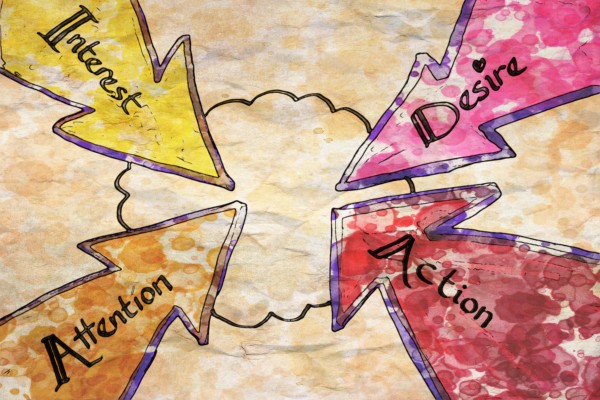
Photo by Lex Mckee
A study from 2010 shows that bilinguals have stronger control over their attention and are more capable of limiting distractions.
When asked to concentrate on a task, the study’s bilingual participants showed an increased ability to tune out distractions and concentrate on the given task.
They were also better equipped to interpret the work before them, eliminating unnecessary information and working on only what was essential.
References:
Ellen Bialystok, Fergus I. M. Craik (2010). “Cognitive and Linguistic Processing in the Bilingual Mind“.
Great news everyone! The recent evidence suggests a positive impact of bilingualism on cognition.
So what exactly does it mean?
The research found that individuals who speak two or more languages, regardless of their education level, gender or occupation, experience the onset of Alzheimer’s, on average, 4 1/2 years later than monolingual subjects did.
What’s more, even people who acquired a second language in adulthood can enjoy this benefit!
References:
Thomas H. Bak, Jack J. Nissan, Michael M. Allerhand, Ian J. Deary (2014). “Does bilingualism influence cognitive aging?“.
I’m not a fan of multitasking since it’s harmful to your productivity.
However, according to research conducted by Brian Gold, learning a language increases brain flexibility, making it easy to switch tasks in just seconds. Study participants were better at adapting and were able to handle unexpected situations much better than monolinguals.
That’s great. But the real question is – why were they better?
The plausible explanation is that when we learn a new language, we frequently jump between our familiar first language and the new one, making connections to help us retain what we’re learning.
This linguistic workout activates different areas of our brain. The more we switch between languages, the more those brain zones become accustomed to working. Once they’ve become accustomed to this type of “workout,” those same areas start helping to switch between tasks beyond language.
References:
Brian T. Gold, Chobok Kim, Nathan F. Johnson, Richard J. Kryscio and Charles D. Smith (2013). “Lifelong Bilingualism Maintains Neural Efficiency for Cognitive Control in Aging“.
Learning a foreign language improves not only your ability to solve problems and to think more logically. It can also increase your creativity, according to Kathryn Bamford and Donald Mizokawa’s research.
Early language study forces you to reach for alternate words when you can’t quite remember the original one you wanted to use and makes you experiment with new words and phrases.
It improves your skills in divergent thinking, which is the ability to identify multiple solutions to a single problem.
Language learners also show greater cognitive flexibility (Hakuta 1986) and are better at figural creativity (Landry 1973).
References:
Kathryn W. Bamford, Donald T. Mizokawa (2006). “Additive-Bilingual (Immersion) Education: Cognitive and Language Development“.
It sounds impressive, doesn’t it? But before we move on, let’s clarify what executive functions are:
Executive functions (also known as cognitive control and supervisory attentional system) – is an umbrella term for the management (regulation, control) of cognitive processes, including working memory, reasoning, task flexibility, and problem solving as well as planning and execution. – Wikipedia
The body of research has shown that bilingual individuals are better at such processes; suggesting an interaction between being bilingual and executive functions.
As Anne-Catherine Nicolay and Martine Poncelet, a pair of scientists from Belgium, discovered in their research, learning a language improves individuals’ alertness, auditory attention, divided attention, and mental flexibility. The more you immerse yourself in the new language, the more you hone your executive functions.
In another study, Bialystok gave study subjects a non-linguistic card-sorting task that required flexibility in problem-solving, filtering irrelevant information, as well as recognizing the constancy of some variables in the face of changes in the rules.
Bilingual children significantly outperformed their monolingual peers in this task, suggesting the early development of inhibitory function that aids in solving problems that require the ability to selectively focus attention.
References:
– Bialystok E. (1999). “Cognitive complexity and attentional control in the bilingual mind“. Child Development 70 (3): 636–644)
– Anne-Catherine Nicolay, Martine Poncelet (2012). “Cognitive advantage in children enrolled in a second-language immersion elementary school program for three years“.
In one study, bilingual children were presented with the problems of both mathematical (arranging two sets of bottle caps to be equal according to instruction) and non-mathematical nature (a common household problem represented in pictures) and were asked to provide solutions.
They were rated on scales of creativity, flexibility, and originality. The results confirmed that the bilingual children were more creative in their problem solving than their monolingual peers.
One explanation for this could be bilinguals’ increased metalinguistic awareness, which creates a form of thinking that is more open and objective, resulting in increased awareness and flexibility.
References:
Mark Leikin (2012). “The effect of bilingualism on creativity: Developmental and educational perspectives“.

If you want to create a crazy brainiac, teaching your child another language is a way to go!
According to new research, babies exposed to two languages display better learning and memory skills compared to their monolingual peers.
The study was conducted in Singapore and was the result of the collaboration between scientists and hospitals. Altogether, the study included 114 6 month-old infants – about half of whom had been exposed to two languages from birth.
The study found that when repeatedly shown the same image, bilingual babies recognized familiar images quicker and paid more attention to novel images – demonstrating tendencies that have strong links to higher IQ later in life.
“The power to learn a language is so great in the young child that it doesn’t seem to matter how many languages you seem to throw their way…They can learn as many spoken languages as you can allow them to hear systematically and regularly at the same time. Children just have this capacity. Their brain is ripe to do this…there doesn’t seem to be any detriment to….develop[ing] several languages at the same time” according to Dr. Susan Curtiss, UCLA Linguistics professor.
Past studies have shown that babies who rapidly get bored with a familiar image demonstrated higher cognition and language ability later on as children (Bialystok & Hakuta 1994; Fuchsen 1989).
A preference for novelty is also linked with higher IQs and better scores in vocabulary tests during pre-school and school-going years.
Leher Singh, Charlene S. L. Fu, Aishah A. Rahman, Waseem B. Hameed, Shamini Sanmugam, Pratibha Agarwal, Binyan Jiang, Yap Seng Chong, Michael J. Meaney, Anne Rifkin-Graboi (2014). “Back to Basics: A Bilingual Advantage in Infant Visual Habituation“.
You can never understand one language until you understand at least two.
How many monolingual speakers know what adjectives or gerunds are? Not many. It’s natural. They simply don’t need such knowledge. However, learning a second language draws your attention to the abstract rules and structure of language, thus makes you better at your first language.
Research suggests that foreign language study “enhances children’s understanding of how language itself works and their ability to manipulate language in the service of thinking and problem-solving.” (Cummins 1981).
Read more about improving your listening skills here.
The research shows a high positive correlation between foreign language study and improved reading
scores for children of average and below-average intelligence. (Garfinkel & Tabor 1991).
Read more about reading more efficiently here.
It sounds like a cliche but let’s say it out loud – your chances of employment in today’s economy are much greater for you than for those who speak only one language.
Multilingual employees are able to communicate and interact within multiple communities. With the rise of technology which enables global communication, such an ability becomes more and more valuable.
What’s more, knowledge of a foreign language conveys, among others, that you’re an intelligent, disciplined and motivated person.
Even if being bilingual is not completely necessary in your field, being fluent in another language gives you a competitive edge over your monolingual competitors.
In a survey of 581 alumni of The American Graduate School of International Management in Glendale, Arizona, most graduated stated that they had gained a competitive advantage from their knowledge of foreign languages and other cultures.
They said that not only was language study often a decisive factor in hiring decisions and in enhancing their career paths, but it also provided personal fulfillment, mental discipline, and cultural enlightenment. (Grosse 2004)
Confidence always increases when a new skill is mastered. Learning a foreign language is no different.
It boosts your self-confidence and makes you feel this nice, warm feeling inside.
Knowing a language also makes you more interesting and let’s face it – who doesn’t want to be more interesting?
Evidence from several studies shows language students to have a significantly higher self-concept than do non-language students. (Masciantonio 1977, Saunders 1998, Andrade, et al. 1989).

Photo by Dennis Skley
Bilingual students consistently score higher on standardized tests in comparison with their monolingual peers, especially in the areas of math, reading and vocabulary.
How much better are their results?
Results from the SAT (Scholastic Aptitude Test ) show that students who completed at least four years of foreign-language study scored more than 100 points higher on each section of the SAT than monolingual students. (College Board 2004)
Even third-graders who had received 15 minutes of conversational French lessons daily for a year had statistically higher SAT scores than their peers who had not received French classes. (Lopata 1963)
In a small study, bilingual people were about a half-second faster than monolinguals (3.5 versus 4 seconds) at executing novel instructions such as “add 1 to x, divide y by 2, and sum the results.”
Andrea Stocco and Chantel S. Prat of the University of Washington who conducted the research say the findings are in line with previous studies showing that bilingual children show superior performance on non-linguistic tasks.
References:
Stocco, A., Yamasaki, B. L., Natalenko, R., & Prat, C. S. “Bilingual brain training: A neurobiological framework of how bilingual experience improves executive function.” International Journal of Bilingualism.
Mastering a language is a skill that requires a lot of time, discipline and persistence.
Many people start learning and give up half-way.
That’s why employees who have knowledge of a foreign language are much harder to replace.
Of course, the rarer and /or more difficult the language, the stronger your leverage.
It comes as no surprise that the knowledge of languages can add a little something to your salary.
However, the amount you can get varies significantly from country to country.
So how does it look like for the citizens of the United States?
Albert Saiz, the MIT economist who calculated the 2% premium, found quite different premiums for different languages: just 1.5% for Spanish, 2.3% for French and 3.8% for German. This translates into big differences in the language account: your Spanish is worth $51,000, but French, $77,000, and German, $128,000. Humans are famously bad at weighting the future against the present, but if you dangled even a post-dated $128,000 cheque in front of the average 14-year-old, Goethe and Schiller would be hotter than Facebook. – (www.economist.com)
In the UK, employees who know a foreign language earn an extra £3,000 a year – a total of £145,000 over their lifetime
Companies are prepared to pay workers earning the national average of £25,818 as much as 12% more if they speak or learn a foreign language. For higher earners, the figures are even more startling.
Those earning £45,000 could see a potential cash boost of 20%, amounting to an extra £9,000 a year or £423,000 over a lifetime. – (www.kwintessential.co.uk)
As you can see, knowing a foreign language can be certainly profitable. But please bear in mind that people who know 2 foreign languages earn much more and the reports typically don’t take rare languages into consideration.
There are many reasons why people leave their homeland and move to other places.
Some look for a better life, others try to find political freedom, love or religious tolerance.
Whatever the reasons might be, knowing foreign languages significantly increases your mobility by removing language barriers and increasing the chances of employment.
What’s more, a stay abroad can positively influence your employability even if you come back to your motherland.
The risk of long-term unemployment after graduation was 50% lower for mobile students than for non-mobile students. Even five years after graduation, the unemployment rate of mobile students was still 23% lower. Also 50% fewer mobile students (2%) than non-mobile students (4%) needed more than 12 months to find their first job. – The Erasmus Impact Study
References:
“The Erasmus Impact Study – Effects of mobility on the skills and employability of students and the internationalization of higher education institutions” (2014)
The Principle of Priority states (a) you must know the difference between what is urgent and what is important, and (b) you must do what’s important first. – Steven Pressfield
Learning a foreign language is one of the most complicated skills out there which one can master.
It’s not your typical “to-do list” which usually consists of just a few, simple tasks. To arrive at your final destination (i.e. mastering a language) you need to learn how to prioritize effectively.
Every language learner faces dozens of decisions each day – what should I learn? When to do it? Should it be reading? If yes, what should I read? And so on.
The constant flood of problems you face every day, helps you to become an efficient learner who knows what is important and what is not.

Photo by Sanja Gjenero
Arguably, this is one of the most phenomenal benefits of language learning.
Your language skills tear down all communication barriers in the world. In the era of the internet, you can find friends in every corner of the world. Africa, Asia, New Zealand are just a few clicks away.
Research at the intersection of cognitive science and education has shown that retrieval improves learning in significant ways. Each act of retrieval changes your knowledge, improving the ability to retrieve knowledge again in the future.
References:
Nunes, L. D., & Karpicke, J. D. (in press). “Retrieval-based learning: Research at the interface between cognitive science and education”.
According to a new study, multilingual speakers are more resistant to conditioning and framing techniques, making them less likely to be swayed by such language in advertisements or political campaign speeches.
It seems that foreign-language speakers are more sensitive and observant when it comes to the words they hear and read.
References:
Albert Costa, Alice Foucart, Inbal Arnon, Melina Aparicid, Jose Apesteguia (2014). “Piensa” twice: On the foreign language effect in decision making“.
According to new research, the ability to learn a second language may depend less on linguistic skills and more on the ability to recognize patterns.
In the said study, Frost and colleagues measured how well American students in an overseas program picked up on the structure of words and sounds in Hebrew. The students were tested once in the first semester and again in the second semester.
The results showed a high positive correlation between recognizing patterns in the shapes and learning another language.
“These new results suggest that learning a second language is determined to a large extent by an individual ability that is not at all linguistic,” says Ram Frost of Hebrew University in Jerusalem who conducted the study.
“It’s surprising that a short 15-minute test involving the perception of visual shapes could predict to such a large extent which of the students who came to study Hebrew would finish the year with a better grasp of the language,” says Frost.
“This finding points to the possibility that a unified and universal principle of statistical learning can quantitatively explain a wide range of cognitive processes across domains, whether they are linguistic or non-linguistic,” concluded the researchers.
Researchers from Spain and Germany found that the process of learning a language and acquiring a wider vocabulary has the effect of stimulating the same part of the brain as having sex or eating chocolate.
Language learning triggers a part of the brain known as the ventral striatum, a pleasure center that is activated when people are involved in activities such as sex, drugs, gambling or eating sugary foods.
References:
Pablo Ripollés, Josep Marco-Pallarés, Ulrike Hielscher, Anna Mestres-Missé, Claus Tempelmann, Hans-Jochen Heinze, Antoni Rodríguez-Fornells, Toemme Noesselt. “The Role of Reward in Word Learning and Its Implications for Language Acquisition”.
The results of the recent study showed that bilingualism is highly correlated with the breadth of vocabulary knowledge and reading skill.
In other words, bilingual participants have a larger size of vocabulary knowledge and they enjoy better word reading skills.
References:
Zohreh Kassaian, Saeedeh Esmae’li (2011). “The Effect of Bilingualism on L3 Breadth of Vocabulary Knowledge and Word Reading Skill”.

Photo by Steven L. Shepard, Presidio of Monterey Public Affairs.
That’s right. By learning a new language you will be able to gain insights into a different culture, access and enjoy the different entertainment, arts, and customs that have developed in different regions over the centuries.
You won’t have to be forced anymore to listen to movies with mediocre dubbing. No more awkward mumbling while singing songs of your favorite Japanese band!
I must admit that I didn’t expect that language learning can have such a side-effect. But hey!
Would science lie?
Anyway, speakers of multiple languages have also been shown to be more self-aware spenders, perceiving “hypothetical” and “real” money (the perceived difference between money on a credit card and money in cold, hard cash) more similarly than monolinguals.
One of the implications of the study, according to its authors is that “people who routinely make decisions in a foreign language rather than their native tongue might be less biased in their savings, investment, and retirement decisions, as a result of reduced myopic loss aversion.”
References:
Boaz Keysar, Sayuri L. Hayakawa and Sun Gyu An (2012). “The Foreign-Language Effect: Thinking in a Foreign Tongue Reduces Decision Biases”.
If you think English is enough to get all the information from your area of expertise, think again.
Knowledge of languages improves international information exchange thus contributing to various improvements and developments at a national, regional and local level.
Speaking other foreign languages enables you to tap into the vast ocean of information which was not previously available and to pass it on to others.
While studying another language, you not only learn how to communicate in that language, you also get to know a lot about the country, the culture, and the people. As you progress, you begin to better understand and sympathize with the people who speak the language.
Discovering their history, you experience their pain, share their victories. You begin to see the world through their eyes. And then the magic happens – you create a connection between your own culture and language to theirs and you develop a deeper understanding of your own language and culture.
That often makes you more aware and appreciative of the unique qualities within your own language, people, and culture.
I know. Learning your first foreign language is always hard. You have no plan.
You have no idea what you’re doing and where you’re going.
However, mastering one language teaches you the mechanics and structure behind any language (ok, maybe except Basque). That makes learning another language much easier!
Loneliness sucks. But thanks to your awesome language skills you might be able to drastically increase your options pool.
You will gain instant access to millions of new people who might be your potential partner.
Even ordinary holidays might turn into a love story!
Achieving conversational skills in a language takes anywhere from 4-12 months.
If you aim at native-like fluency it might take much longer.
The language learning journey is fraught with obstacles. Overcoming these adversities is what boosts your confidence and builds character. Every victory, no matter how small, makes you better equipped to handle future challenges and build consistency and persistence.

Photo by Sigurd Decroos
The study conducted in 2011 found that students who were in rigorous programs in high school—that included three years of foreign language study—were more likely to get better grades in college and less likely to drop out. (Horn &Kojaku 2001)
Another study showed that high school seniors with two or more years of foreign language study showed significantly improved performance on achievement tests in English when compared with non-foreign language students. (Bastian 1980)
Bilinguals outperform similar monolingual persons on both verbal and nonverbal tests of intelligence, which raises the question of whether ability in more than one language enables individuals to achieve greater intellectual flexibility (Bruck, Lambert, and Tucker, 1974; Hakuta, 1986; Weatherford, 1986).
Constant struggles with expressing your thoughts in the early stages of language learning force you to change your approach to expressing yourself. You adapt and simplify your thoughts to facilitate communication. The unusual side-effect of this process is that you become a more effective communicator!
Most of us have a job, study, family and other stuff to take care of. That’s why learning a language requires some serious time management skills. Students of foreign languages become experts at using time productively. After all, how many other people listen to language podcasts on their way to work or at the gym?
Source: Foreign Language – Acquisition, Academics and Attitudes

Photo by Riccardo Annandale on Unsplash
The answer is easy – copy, or to be more precise – copy ideas from other countries. It doesn’t matter whether you want to open a restaurant or start a tech business. Start googling in the language of your choice and soon enough you will find lots of ideas you can copy!
Although the report is about Brits, I would say that it’s a safe bet that language speakers are universally more attractive!
The American Academy of Neurology has conducted research which shows that speaking more than one language increases the number of neural pathways in the brain, allowing information to be processed through a greater variety of channels. They’ve also begun to demonstrate that multilingualism improves development in the brain’s areas of executive function and attention, regardless of learner’s age.
Embracing foreign language learning increases your global awareness and understanding. This way, not only do you learn how to communicate in that language but also get to know a great deal more about the country, the culture, and the people. This knowledge is invaluable!“Connecting and joining together with people we have never met and are not related to goes to the very soul and core of our being as humans.” Source: http://www.qlanguage.com.hk/
Learning a new language inspires and encourages you to explore a culture that you have previously only had a slight knowledge of or, worst still, no knowledge of whatsoever. As you progress, you begin to better understand and empathize with the people who speak the language, you learn about their struggles, their history, and even their idiosyncrasies. Simply put, you get a much closer and fascinating insight into what makes them tick!
Moreover, as your empathy and knowledge of their culture grow, something magical begins to happen: you form a connection between your own culture and language to theirs, and you begin to gain a deeper and more profound understanding of your own language and culture. Very often, you become more aware and appreciative of the unique qualities within your own language, people and culture.
Many people disregard this fact but learning a language is one of the most challenging skills out there. To acquire native-like abilities in understanding, speaking, reading and writing a language, as well as a knowledge of the culture of those who speak it, could take anything from five years to a lifetime.
To achieve your goal, you need to :
Another benefit of learning a foreign language is being able to understand and appreciate the arts of another country at a more profound level. As you learn the language and history of Greece, for example, you begin to understand Spanish music, films, and literature.
Let’s take the literature as an example. Very often, the true meaning of words is lost during the translation. Some things simply cannot be translated. Your native language doesn’t have the same words or phrases as every other language. Learning a language will allow you to truly explore the texts you’re reading.
There is a large body of research proving that learning languages can narrow achievement gaps (source: NEA Research, December 2007)
Children of color, children from economically disadvantaged backgrounds, and English Language Learners make the most significant proportionate achievement gains from foreign language study.
Early foreign language study is less dependent on previous verbal learning than most other elements of the elementary school curriculum, and this allows some students to succeed who have otherwise experienced repeated failure in school. (Curtain & Dahlberg 2004)
“The limits of your language are the limits of your world” – Ludwig Wittgenstein
Most locals appreciate and reward your willingness to communicate in their native tongue. I’m not a much of the traveler myself, but whenever I spoke the language of the country which I was visiting, the reaction was nothing short of heart-warming! I was encouraged and praised for my language skills, even though I made dozens of mistakes.
Many would argue that bilingualism is becoming a progressively necessary and essential skill for anyone who wants to keep up with today’s rapidly increasing global economy. As more and more people recognize the importance of learning an additional language, those who only speak one language will begin to get left behind in our shift towards a more integrated and connected global society.
Speaking a different language means that you are constantly confronted with new ways of thinking about the thing you thought you knew.
Mixed metaphors and phrases change the way you think, and benefit abstract and creative thinking since you acquire multi-faceted view on the world.
As your brain works to process a new language, memory, reasoning, and analytical thinking are heightened.
Your information is only as useful as your sources of information. Looking for it in only one language isolates you from thousands of other sources, research results, etc. Very often, they are the ones who offer an interesting angle on the matters of your interest because of cultural differences.
The above is true in many ways. The apparent benefit of language learning is that a new language gives you the ability to communicate with different people on more meaningful levels.
The less obvious is that by practicing it, you also hone your communication skills generally. You acquire new perspectives and skills that help you express yourself better and understand others more completely.
Finally, learning a new language makes you think differently about your own, providing clarity, complexity, and a deep understanding of others.
75 % of the world doesn’t speak English at all. Do you know what it means for your business? It means that you’re limiting your pool of potential customers. Sure, it might not be the case if you have a small grocery shop. But for others conversing in the client’s language helps to understand his needs.

Photo by Karim MANJRA on Unsplash
Several of the studies reviewed in a 2011 paper by Finnish music and education researcher Riia Milovanov and her colleagues, showed that mastery of more than one language as well as mastery of music involves higher levels of executive control.
These are the mechanisms responsible for the overall management of cognitive resources and processes – including attention shifts, working memory, reasoning, and switching between tasks.
Other studies reviewed in the same article showed that musical training correlates with better language-learning skills. Learners with a musical background were found to be better at pronouncing the sounds of a second language and at perceiving the relevant contrasts between sounds in that new language.
Learning and practicing something, for instance, a second language, strengthens the brain,” said Ping Li, professor of psychology, linguistics and information sciences and technology. “Like physical exercise, the more you use specific areas of your brain, the more it grows and gets stronger.”
Li and colleagues studied 39 native English speakers’ brains over a six-week period as half of the participants learned Chinese vocabulary. Of the subjects learning the new vocabulary, those who were more successful in attaining the information showed a more connected brain network than both the less successful participants and those who did not learn the new vocabulary.
The researchers also found that the participants who were successful learners had a more connected network than the other participants even before learning took place. A better-integrated brain network is more flexible and efficient, making the task of learning a new language easier. Li and colleagues report their results in a recent article published in the Journal of Neurolinguistics.
The researchers defined the efficiency of brain networks in terms of the strength and direction of connections, or edges, between brain regions of interest, or nodes. The stronger the edges going from one node to the next, the faster the nodes can work together, and the more efficient the network.
Participants each underwent two fMRI scans — one before the experiment began and one after — in order for the researchers to track neural changes. At the end of the study period, the researchers found that the brains of the successful learners had undergone functional changes — the brain network was better integrated.
Such changes, Li and colleagues suggested while reviewing several related studies, are consistent with anatomical changes that can occur in the brain as a result of learning a second language, no matter the age of the learner, as they reported in a recent issue of Cortex.
“A very interesting finding is that, contrary to previous studies, the brain is much more plastic than we thought,” said Li, also co-chair of the interdisciplinary graduate degree program in neuroscience. “We can still see anatomical changes in the brain [in the elderly], which is very encouraging news for aging. And learning a new language can help lead to more graceful aging.”
Meanwhile, Li and colleagues have begun working on interactive ways to teach language using virtual 3-D-like environments with situation-based learning to help the brain make some of those new connections more effectively. Such studies hold the promise that the process of learning a second language as an adult can, in fact, lead to both behavioral and physical changes that may approximate the patterns of learning a language as a child.
Source: News.psu.edu
Another study from 2017 hinted that foreign-language speakers turned out to be less averse to violating the taboos that can interfere with making utility-maximizing choices. As a consequence, they can make better decisions.
Source: ScienceDaily (2017)
Learning a language is always a challenge. It takes sweat and tears.
But amazing things happen once you achieve at least communicative fluency.
At that point, you can relax and use your language skills to acquire new knowledge effortlessly.
For example, I spend at least 2-3 hours per day learning medicine in English, German, and Spanish.
This way, I can improve my language and general knowledge at the same time.
Another great news for language learners is having more opportunities to find a job and develop professionally.
A wider perspective and more options is based on in-depth interviews with humanities graduates from the 1970s onwards and captures something of the diversity of career paths followed by graduates in so-called ‘non-vocational’ disciplines.
References: 2006 report by the Higher Education Academies

Photo by Freddie Sze on Unsplash
The research from 2014 shows that simple mistakes in spelling or comprehension that our brains tend to make when taking linguistic shortcuts (such as how you can easily read “tihs senetcne taht is trerilby msispleld”), are easier to avoid for multilinguals.
Reference: Albert Costaa, Alice Foucart, Inbal Arnon, Melina Aparici, Jose Apesteguia; “Piensa” twice: On the foreign language effect in decision making (2014)
Another benefit of language learning is having a chance to experience the world in a much richer way.
“Thierry et al. studied how having different words for different colors in one language might affect the perception of that color as compared to a language that does not discriminate between those colors. In Greek, “light blue” is distinguished from “blue”, not simply as a different shade but as a whole different category of color. In this study, bilingual and monolingual Greek/English participants were shown different shades of blue and light blue as well as green and light green (for which a distinction is not made in Greek) and ERPs were recorded. Electrophysiological measures showed a distinct pattern for the bilinguals indicating that they were perceiving the two colors as completely separate.”
Another study confirmed that learning a language influences the perception of color as well as the categorization of objects.
This phenomenon is also evident in Japanese. The language has basic terms for light and dark blue, which may help you perceive the color in different ways (Athanasopoulos et al., 2010).
Language has also been shown to change the way people think financially. A study covered by Jessica Gross on the famous TED.com found that “Futureless language speakers are 30 percent more likely to report having saved in any given year than future language speakers” (Chen) because their language was tailored to the present.
Knowing more languages can help you in the long run economically, as you will have more ways of thinking about the same things. So, in the long run, learning, a second language is an investment in your future.
It doesn’t matter whether you’re a lonely cowboy roaming the language wasteland or you learn in a group. Language learning encourages the development of self-management skills.
An essential part of these skills is engaging in a critical dialogue with yourself by continually questioning whatever you’re currently doing. Not a day goes by without asking yourself the following questions.
Am I using this word correctly?
Should I use this or that grammatical construction?
Does X sound natural?
Etc.
Reference: Honeybone, A., Brossier, V. (2000) ‘The University of Hertfordshire environmental French program’ in King, A. (ed) Languages and the Transfer of Skills (London: CILT), pp. 102-109
Have you ever heard of delayed gratification? If yes – congratulations, if not, please allow me to quote the omnipotent Wiki:
“Delayed gratification, or deferred gratification, is the ability to resist the temptation for an immediate reward and wait for a later reward. Generally, delayed gratification is associated with resisting a smaller but more immediate reward in order to receive a larger or more enduring reward later.[1] A growing body of literature has linked the ability to delay gratification to a host of other positive outcomes, including academic success, physical health, psychological health, and social competence.” Source: Wikipedia
So what does it have to do with languages, huh? Language learning is the pinnacle of delayed gratification. Maybe with the exception of the beginning of this process.
So what does it have to do with languages, huh? Language learning is the pinnacle of delayed gratification. Maybe except the beginning of this process.
You see, initially, the language gains are massive. You seem unstoppable and find great joy in learning. However, after some time, most learners hit the language learning plateau.
Gains are not that significant anymore. You can learn for many weeks and still have doubts about whether you make any progress. This trial by fire teaches you patience, humility, and determination. This is the skill which many learners transplant into other areas of their life like improving their health, learning how to play an instrument,m, etc.
Read more about how to overcome a language learning plateau.

Photo by Perry Grone on Unsplash
Many language courses involve working in groups and making formal presentations in front of an audience. It’s just the sort of teamwork and presentational skills which employers tell us they are looking for.
By carrying out such tasks, language learners ae in reasoning clearly and in presenting focused arguments.
The mention of such courses in your CV might be a welcome addition for many employers.re trained to think structurally.
Reference: King, A., Thomas, G. (1999) The Guide to Languages and Careers (London: CILT)
I have already mentioned that one of the benefits of language learning is being able to tackle complex issues. A side effect of this skill is being able to formulate problems clearly. After all, you can’t solve anything if you don’t know what stands in your way.
Reference: Centre for languages, linguistics & area studies
Ordinary people are often perplexed why serious language learners devote so much time to their passion, “What’s in it for them”? “Why do they have to be so weird?!”.
The truth is that most language learners start small. They want to learn one language for the sake of work/relationship, etc. However, once they get the taste of success, they want more. So they learn another language and then yet another one! The party never ends. Let’s be honest. For most of us, the first language is just the beginning.

Many people are in love with the idea of being knowledgeable. Sadly, not many believe that they can acquire enough knowledge. Being able to move through life and overcome all the obstacles effortlessly seems to be reserved mostly for the gifted or unrelatable movie characters.
A big part of the problem is the general inability to acquire considerable amounts of information. However, the other obstacle is deciding what's worth learning. If you don't know where you are headed, you're like a drunk bouncing from one lamp post to another in a twisted version of pinball. The next thing you know is you wake up with a bad headache and a bitter taste of disappointment in your mouth.
There is an easy fix for this - focusing on evergreen knowledge.
The problem with acquiring knowledge randomly is that most of the time if you can't use it, you will lose it. Sure, some bits stay with you throughout your life. Regardless, most of this knowledge will be inevitably lost. So will be your effort and time. I know that many say that spending your time learning is always a good investment.
But is it really?
If I spent 50 hours trying to acquire knowledge and my recall rate, or should I say - return rate, would be 1, 2 or even 5 %, I would be pissed. It would mean that for every 1 hour I spent learning, not more than 3 min were used effectively. That's a very definition of a stupid investment. Sure, you can argue that I have jogged my brain, and tried, and bla bla bla. Still, 5%? Come on!
If I retained that little, I wouldn't even bother learning. I would spend time with my family or binge-watch TV series. Learning is not fun if you can't hold on to any information.
But the evergreen knowledge is different. It's immediately applicable. Every minute you spend acquiring it can give you immense returns on any given day of your life.
The immediate applicability of such knowledge bleeds directly into every area of your life and makes it easier. It allows you to get the most of out of the most ordinary situations and encounters.
Where other people struggle, you see opportunities. It's a real game-changer regarding how you live your life.
If you have wanted to become a serious learner, but you have never known what to focus on, a list of evergreen skills can give you a clear sense of direction—no more fumbling in the dark. Check one thing off your list and move on to another. In the meantime, watch how much your life changes.
I think that the most important method to establish what constitutes evergreen knowledge is to ask yourself the following questions:
As a result, you should arrive at the right answers.
Of course, it's worth pointing out that defining what's evergreen is not always perfectly possible. We are all different in some regards. I believe that this distinctiveness should be reflected in the definition of evergreen knowledge.
I like to explain this issue, as contradictory as it might sound to some degree, that evergreen knowledge can be divided into two categories:
This category envelopes all the skills and information that are truly necessary to function in any society, country, or profession. Everyone is forced to rely on this knowledge every single day.
This would be the knowledge that's specific to your type of personality, interests or a career path you have chosen. It is the instance where one man's trash is another man's treasure.
Some of the skills I consider evergreen would be treated as an utter waste of time for you. The opposite is true, as well.
If you're a dog person, knowing a lot about how to take care of your pet would be considered evergreen. That wouldn't be the case for anyone who generally dislikes animals.
The same would be true for anyone whose area of speciality oscillates around material engineering. In that case, advanced knowledge of chemistry and physics would be a must. Would this kind of knowledge be useful for you and me? Highly unlikely.
This is an area that applies directly to my life. I am an active trader, and I focus mostly on short-term investments. To be able to do it effectively, I need lots of information regarding the branches that interest me.
Of course, this kind of knowledge would be useless to a non-investor.
This is a moment where we should make a distinction between news and information.
Information is a representation of knowledge that feeds your decision-making process. It's almost immediately valuable and useful.
News is just noise - worthless bits of trivia that do nothing to improve any area of your life and feed mostly primitive, emotion-driven parts of your brain.
Unfortunately, I can't help you with deciding what knowledge is personally evergreen for you. This is a one (wo)man job, and you're the person to do it. I would suggest you take your time and compile a list of skills that will be of immense help to you.
In this article, I prefer to focus on universally evergreen skills and why they are worth learning.
For your convenience, press a link to go to the chosen section.
These are the skills that I deem universal for any adult. Not only do they allow you to build a successful and happy life, but also will enable you to overcome any hurdles that you might stumble upon.
Usually, I am first to admit that I am biased in some areas. However, this time, I believe I am stating the obvious.
Knowing how to learn effectively is the single most crucial skill you can master in your life.
Nothing else comes even close. I know that educators from lots of other fields say the same thing about their specialty. They say that mathematics is the king, chemistry is the queen, painting with watercolors is the very essence of life and all that jive.
The thing is that without the knowledge of how to acquire information properly, you will quickly forget all the other information. This way, your life turns into a twisted version of alcohol-infused reality. You learn to wake up the next day and realize that all you have is vague recollections of what you did the night before.
The art of learning should be the very first thing we teach our kids at school. If we did, the standard of living in most countries would rise dramatically. We're talking about flying toilet bowls, and laser sabers here!
Sadly, this world doesn't exist. All we have is an endless game of playing intellectual catch-up and being happy with achieving survival level of professional competence.
Money is an indispensable part of our lives. Yet, not many people take their time to learn how to handle it.
Saving is considered this thing that crotchety old people do. Investing is deemed as a gateway drug to becoming a blood-thirsty, three-piece suit capitalist - not something that honest people do. Budgeting seems like a good idea only when your financial situation is so dire that when you open a toilet bowl, a court executioner pops up humming "Money money money."
Generally, I think that learning more about Business and money is a great way to not only guarantee you financial stability but also to multiple what you already have.
Analytical skills is an umbrella term for subskills such as:
The amount of knowledge in the world is growing at a dizzying pace.
"Buckminster Fuller estimated that up until 1900 human knowledge doubled approximately every century. By 1945 it was doubling every 25 years, and by 1982 it was doubling every 12-13 months. IBM estimates that in 2020 human knowledge will be doubling every 12 hours." - Modern Working Place
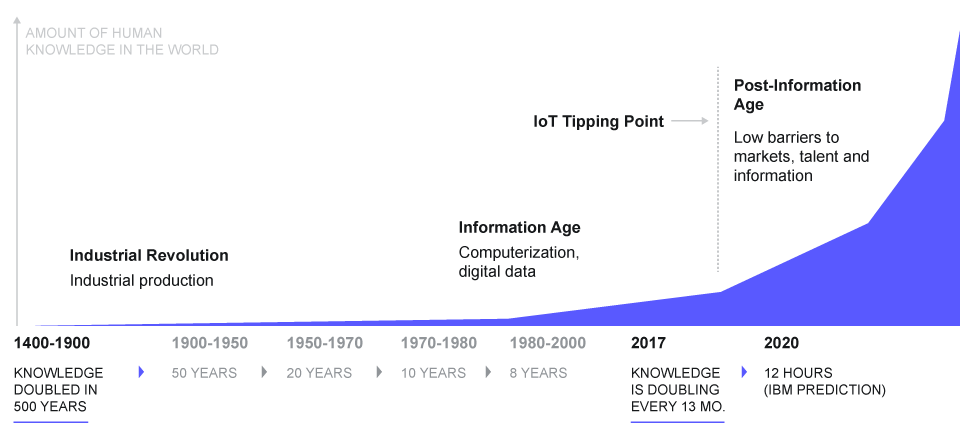



In theory, it should be great news. More knowledge and better access to it means that the quality of our lives and decisions should be increasing as well; except it doesn't.
The most prevalent reactions to this information overload are either:
Analytical skills are the only way out of this madhouse. They allow you to apply a calm, cold, methodical approach to every problem. In the era of widespread misinformation and ignorance, this knowledge seems to be more critical than ever.
Just in the last couple of weeks, we have all had a chance to read the COVID-19 is a hoax created by lizard people who are transmitting via 5g technology. All this to inject you with a bogus vaccine that contains a chip that will travel to your brain to control your bowel movements. What a time to be alive.
Of course, establishing whether something is true or not is a process. It requires suspending your belief and opinions until you learn more about a given subject. Unfortunately, not many people are willing to take their time to do it.
Considering that eating is something we do multiple times per day, it seems crazy for me not to study this topic in-depth. Your health is dependent on how good your diet is and how happy or miserable your life will be. It was the main motivation that led me to become a certified nutritionist.
Interestingly enough, becoming knowledgeable in this field requires a mix of other evergreen skills, namely:
If you accept current nutritional recommendations from your government without doing any proper research and knowing how to interpret the data, you are going to have a bad time.
Just the other day, I had a consultation with a woman who religiously followed all the current guidelines—lots of green veggies, whole-weed bread, etc. She also suffered from a hypothyroid and couldn't fix it even with drugs. You can imagine her shock when I explained to her that cruciferous vegetables that she consumed 5 times per day block absorption of iodine and impair the function of the thyroid. The same goes for the infamous gluten. After eliminating those foods from her diet (and some others as well) and adding some supplementation, her thyroid was alive and kicking in about 4 weeks.
Many people treat doctors as an excuse to ignore this field of knowledge. After all, you are not a trained professional, so why would you even bother?
The reasons are plenty. First of all, modern medicine is strictly drug-based. While it's entirely ok in some, especially acute cases, it's subpar or harmful in others.
Secondly, no doctor will follow you around to check whether you or your relatives are ok. Some basic medical knowledge will allow you to spot many health-related problems from miles away. What's more, no doctor will care about the well-being of you and your family as much as you do. It's precisely this emotional engagement that allows people to dig way deeper into potential solutions than many medical professionals.
Last but not least, there are not many good specialists in any area, including medicine. I used to live in this conviction when I was younger that every doctor is a giant, squishy brain with legs attached to it. Sadly, once I started teaching medical professionals how to learn, I quickly realized that they struggle a lot with remembering. Of course, that weighs a lot on potential diagnoses.
Personally, I can't get enough of this domain. So far, I have created 30k + flashcards from this discipline and did governmental certification to become a trichologist and personal trainer, and I know it's just the beginning!
Productivity is another essential skill everyone should learn. You're going to work most of your life. Being able to get the most out of it is an obvious choice.
Productivity includes subskills, such as:
This skill tied beautifully with knowing how to learn. Once you get a grasp of how to acquire knowledge effectively, increasing your productivity will allow you to work more efficiently and realize projects related to the information you have acquired.




Photo by Sharon Pittaway on Unsplash
More and more people are getting anxious about the changes our world is going through. AI and the ubiquitous automation threaten to make dozens of professions obsolete in the upcoming decades. And rightly so - it's not fear-mongering. The process is happening as we speak, starting from self-driving cars, warehouse robots, and ending with the pattern-matching AI software. Heck, not that long ago, a Japanese company replaced office workers with artificial intelligence.
However, there is one thing that won't be replaced for a long time, or maybe ever—our boundless creativity and all the emotions that underpin it.
Of course, opinions about whether creativity is something uniquely human are split. However, we can't argue about is that AI programs are typically good at just one thing. Moreover, they need millions of data points to be able to perform this activity.
The same constraints do not limit us. We still need input, but unlike machines, we can make crazy logical and creative leaps between seemingly unrelated subjects.
It's quite a safe bet that unless the processing power of computers increases by hundreds, if not thousands of times or more, the true creativity will remain a hallmark of humanity.
The big advantage is that just learning a couple of basic strategies can make you a way better thinker and problem-solver.
Whether you like it or not, public speaking is yet another skill that we cannot escape. Depending on your line of work, you will be forced to step in front of a bunch of people quite often enough.
Learning the basics of public speaking will allow you to feel more confident and make a far better impression than you would otherwise. If you have experienced the soul leaving your body during one of such presentations, you know what I mean.
What's more, it doesn't take much time to acquire this knowledge at a satisfactory level, which makes it even more logical choice for your to-do list.
If there is one thing we are not short of is problems. Every day we face dozens of decisions and dilemmas of different magnitude. Being able to tackle them in a systematic way is a very desired competence.
Problem-solving skills include subskills such as:
What's more, it can be reinforced by many other skills on the list like knowing how to learn, creativity, psychology, and analytical skills.
Psychology is the science that studies what influences our minds and behaviors. It's a critical component of our everyday lives. It helps to unveil all the hidden and unconscious mechanisms that drive our lives.
Studying psychological concepts will allow you to both improve relations with your directs surroundings as well as learn how to stop sabotaging ourselves and get out of your own way.
Once again, there is a certain overlap between psychology, creativity, and problem-solving.
Psychology was my first love way before the memory came into the picture. I was brought up in a dysfunctional family. My father was a mean, abusive alcoholic, and that inevitably shaped me as a young kid - and not in a good way. I was terribly aggressive and constantly got into trouble.
When I was about 11 or 12, I entered a bookshop and out of boredom picked up some random psychology book because it sounded smart. My life has never been the same since then. Concept by concept, I could understand where my behavior and actions came from, and I began to fix them. This is the power of psychology - 10/10 would recommend.
One of the most readily accessible subbranches of psychology is the art of persuasion. We all have to "sell" ourselves or our ideas in one way or another. You might as well learn how to do it effectively!
It's also worth keeping in mind that the art of persuasion is a double-edged sword. It can also be used against you as a tool of manipulation. Even if you're not interested in learning it to become more convincing yourself, it's worth doing so to become aware when others try to manipulate you.
As the old poker adage goes, if you don't know who the sucker in the room is, it means you are the sucker.
The law doesn't evoke the most pleasant associations. Regardless, our every action is bound by it. Sadly, like many other evergreen skills, it's usually brushed off throughout the education system.
Learning its basics, be it, basic humans rights or tax regulations, will allow you to become a more aware citizen as well as bring you many other benefits, including the financial ones.
Economics is a field of science that explores how society uses its limited resources to best meet its needs. Both macro- and microeconomics can be applied to many other branches of knowledge, making it a universal tool to understand the economic reality we live in.
You can use it mostly to optimize your financial decisions. It can come quite handy both in investing or choosing the right moment to purchase different goods.
Physics is one of a few branched that made the modern world possible. Its applications can be found all around us in every device we use: batteries, cell phones, computers, cars, and constructions of any kind.
Even though it seems abstract at first, it can help you get a better grasp of dozens of everyday phenomena. I find it especially practical when combined with other evergreen skills like nutrition, medicine, and chemistry.
For example, my mom is a cosmetician, and I have always been, somewhat organically, fascinated by this field. One of the cosmetic preparations that are all the rage among ladies is hyaluronic acid.
Very often, it is as expensive as hell. What's more, companies do their best to convince you that it can miraculously regenerate and moisturize any type of skin even if it looks like a 15-year old tire. Sadly, these claims don't hold true. Once you learn a bit about dermatology and combine it with physics (i.e., the concept of permeability), you will realize that most hyaluronic acid preparations are too big to pass through the first layer of skin called stratum corneum. Just like many other preparations, I might add.
You see? A bit of reading will have saved you thousands of dollars.
I still remember this memorable saying from school that chemistry "feeds, heals, clothes and defends." It's true.
Chemistry is a tenacious companion of our everyday struggles. It can be found in cosmetics, drugs, clothes, cleaning products and weapons. Knowing just a bit of chemistry can be extremely helpful, especially if you combine it with other evergreen skills.
Personally, I love how medicine and chemistry go hand in hand. For example, once you learn about displacement reactions, you can apply this concept to understand one of the causes of hypothyroid.
It turns out that halogens, i.e., elements like chlorine, bromine, and fluoride, can displace iodine that is responsible for producing your main thyroid hormones. In other words, accidental drink of the tap or swimming pool water or eating your toothpaste might mess you up.
The same goes for drinking too much tea because its leaves, especially young ones, are full of fluoride.
Everything is connected, and chemistry is an integral part of the whole.




Photo by JESHOOTS.COM on Unsplash
I love mathematics with all my heart. This was one of the mains reasons why I chose Econometrics as my major. That's why it hurts me a lot to see a lot of disdain for mathematics these days. All of a sudden everyone seems convinced that calculators and Excel are our saviors.
It's painfully wrong. I agree that not many people need to know advanced math. However, a lot of basic concepts and a general numerical is necessary.
I would argue that basic statistics is one of the most mat skills one can possess. Without them, it's difficult to interpret any scientific research or even numbers communicated to us by our governments.
There is no denying that we spend almost every day plugged to digital reality. There is little hope that it will ever change.
For that reason, it's definitely worth learning a bit about computers, programming languages and even network infrastructure. It doesn't take much time, but it can certainly improve your understanding of this area of life.
If your native tongue is anything else than English than knowing at least this one language is undoubtedly an evergreen skill. English is the language of knowledge; the modern Latin if you will. If you want to know anything about anything, you need to know it.
However, even if you're an already native speaker, mastering another language should be a must based on the cognitive benefits it delivers.
Nevertheless, I don't think you should overdo it. I believe that knowing more than three foreign languages is rarely practical and worth your time unless you really love this area of knowledge, or you have other good reasons.




Photo by Dominik Vanyi on Unsplash
I know what you're thinking. Playing an instrument is a direct contradiction of my definition of evergreen skills. It's certainly not something one does every day.
I have placed it on my list because just like languages, it's one of the best cognitive boosters in the world. If you care about your or your children's mental well-being, I would consider putting it on your to-do list.
It sure as heck is more effective than investing in some stupid brain-training games or thinking that Sudoku will enlarge your brain enough as to bend space-time.
"Children exposed to a multi-year program of music tuition involving training in increasingly complex rhythmic, tonal, and practical skills display superior cognitive performance in reading skills compared with their non-musically trained peers, according to a new study." - Science Dailly
"Musical training seems to hone auditory memory skills. Musicians have better auditory working memory (Chan et al., 1998; Jakobson et al., 2008; Parbery-Clark et al., 2009b, 2011a; Strait et al., 2012b, 2013a), potentially accounted for by musicians' increased activation of larger neuronal networks involved in cognitive control and sustained attention than non-musicians when confronted with difficult memory tasks (Gaab and Schlaug, 2003; Pallesen et al., 2010)." - Art and science: how musical training shapes the brain
"Musicians have a larger corpus callosum, the fiber tract underlying most interhemispheric communication, with musicians who started training at an earlier age having a larger corpus callosum compared to musicians who started later (Schlaug et al., 1995; Wan and Schlaug, 2010). Musicians' larger corpus callosum volume may reflect decreased interhemispheric inhibition (Ridding et al., 2000) and more communication between the two hemispheres."
Evergreen skills are easy to activate by their very nature. However, a great way to use them at the same time is to come up with a project.
Most of the projects are characterized by a high degree of complexity and necessitate the use of many different skills. What's more, they are a preferable way for many people to learn. Not everyone can pore over books for months without any specific purpose. Projects, on the other hand, are meaningful and highly engaging.
They can also be a gateway to a better and more successful life - also financially. For example, I did my trichology certification for fun, as a personal project. Would it be difficult to open my practice or team up with someone to open a clinic? I don't think so. Nevertheless, it all started as a fun side project.
Think whether there is something you have always wanted to do or create and start working towards it step by step. Acquire all the necessary evergreen skills on your way there and observe how much easier your project comes. There are truly few things in life that give as much satisfaction as seeing your vision come to life.
Evergreen skills and knowledge should be a top priority for any ambitious individual. The time you devote to their development is among the best investments in life you can make as they can be used in every single area of your life.
The best part is that the more of them you learn, the more powerful those evergreen skills become. It's a beautiful demonstration of the synergy effect where the sum of parts is way greater than the individual part themselves.
Which of those skills is the most important for you? Let me know in the comments!
Reading articles online is a great way to expand your knowledge. However, the sad thing is that after barely 1 day, we tend to forget most of the things we have read.
I am on the mission to change it. I have created over 43 flashcards that you can download to truly learn information from this article. It’s enough to download ANKI, and you’re good to go. This way, you will be able to speed up your learning in a more impactful way.


“Repeat after me!”
Repetitio mater studiorum est.
Spending time with my grandfather was always a bit weird. He didn’t want to talk much or play some stupid games. Oh no. He used to sit me in front of him and grill me about different school subjects. Physics. Math. History. But his personal favorite was teaching me Latin proverbs.
Most of them slipped my mind.
But among all those which stuck with me, this is the one I cherish the most:
Repetitio mater studiorum est – repetition is a mother of studying
These four words contain the wealth of wisdom if you only interpret them in the right way.
On the surface, the problem with learning doesn’t seem that complex. As long as you repeat things you want to learn, everything is fine and dandy. But let’s be honest for a second.
How easily can you recall words during conversations in your target language? How often does your mind go blank?
You desperately try to recall the word you need, but there is nothing there — just the depressing nothingness.
Rings true? There you have it!
So the problem might a bit more complicated than we have thought after all. Put on your “learning overalls,” and let’s dig deeper to explain why repetition is not enough.
Let me start with the basics.

In its most basic form, the repetition can adopt two forms. It can be either:
But what does “passive” mean, especially in the context of language learning?
It means that you don’t engage with the information you receive.
You don’t do it actively (duh). That’s why activities like reading and listening fall into this category. What terrifies me the most is that the default style of learning, for most of the people, is passive learning.
“But why do passive learning activities suck donkey balls?”, you might ask. Let’s get to it.
Before I get to the science, let me tell you about a friend of mine. This story might sound familiar to you. Problems of about 90% of people who write to me fit perfectly into the following scenario.
Anyway. So this friend of mine has been learning Russian for over two years now.
I haven’t heard her talk for a long time, but I thought that her level should be at least decent.
Russian is not that different from Polish, after all. So imagine my surprise when I heard her speak Russian a few weeks ago. She barely scratched the B1 level.
My first reaction? “No, f***ing way.”
She’s been learning systematically for over two years, and she can barely string a sentence together? After some investigation, I got to the bottom of it. Yes, her teacher visited her every week. Yes, they did learn.
Or should I say, “learn”? Because the process they went through barely resembled any real learning. They read some articles together. For an entire hour. Almost no speaking at all. No meaningful conversations. No active learning.
Nada. Null. Nothing.
If at any point while reading this description, you told yourself, “Hey, this is pretty much how my lessons look like!” then run. Run the hell away from your teacher or language school. A visit to a local strip-club seems to be a better investment than this. At least you will know what you pay for.
Science is very clear about passive learning. It was proven a long time ago that passive learning has minimal effect on whether the information is later recalled from long-term memory (Craik & Watkins, 1973).
Many other studies have managed to replicate the results of the research mentioned above successfully.
So how does effective learning look like? Take a look at the pyramid of effective learning.
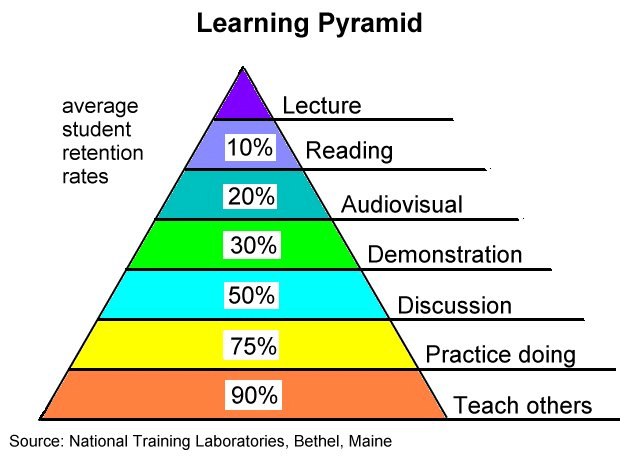
There is a good reason why learning and listening are at the absolute bottom of retention rates.
Effective learning requires , so-called, effortful recall.
This should be the mantra of every learner. If you want to learn fast, you have to take control of your learning. Without it, your learning is like a boat with no sails in the middle of the storm. You go one way and then the other without any sense of direction. That damn boat needs a captain – you that is!
Ok, so what does the effortful recall mean?
It means that the more effort you put into recalling a piece of information or executing a skill, the more this act benefits the learning. (Make it Stick: The Science of Successful Learning by Peter C. Brown, Henry L. Roediger III, and Mark A. McDaniel).
Once again, there are a lot of studies that confirm the effectiveness of active learning. Here are the results of some of the recent findings.
“Tests that require effortful retrieval of information (e.g., short-answer) promote better retention than tests that require recognition (Larsen et al. 2008).”
“Effortful retrieval of information improves recall 1-month later, compared with no test (butler and Roediger 2007).”
It’s worth mentioning that you can mix these strategies. Why not reap the benefits from the synergy effect?
Let’s do some simple math. Considering the said effectiveness of given learning strategies, we might conclude that:
One minute of talking is worth 5-7 minutes of reading/listening (read more about the benefits of talking to yourself).
I know that reading and listening might feel productive, but they are not. These are so-called feel-good activities.
I always shock students of mine by telling them not to listen to anything for the first 8-10 weeks of learning. Instead, I help them concentrate on active learning. Only after this period do they start listening practice. And the gains always amaze them.
There is also a little known consequence of your potential choice of learning strategy. You see, if you don’t learn actively, you automatically condemn yourself to UNINTENTIONAL LEARNING.
*gasp*
Now, this is a truly fascinating type of learning.
Unintentional learning takes place when you acquire vocabulary accidentally. It is a by-product of repeating a given piece of information a certain number of times.
It’s worth mentioning that is it also one of the default and (most useless) strategies of almost every language learner.
The body of research shows that you need to repeat a piece of information (unintentionally) between 20 and 50 times to put it into your long-term memory. 20 to 50 times! (one of many sources)
It takes way too much time. And time is the luxury a few of us can afford. Of course, One might argue that 20-50 repetitions are not that many. After all, if you read extensively and listen, you should get to this number of repetitions after some time.
Right? No. Here comes another plot twist.
Unless you learn three thousand words, reading is a very slow and inefficient activity.
And until you reach this number, your odds of learning words contextually are slight. Sure, you can infer the meaning, but there is a good chance that your guess will be incorrect.
And what about rare words which you might find useful?
What If I need to know the word “thimble” because that was my dog’s name, and I feel the need to share it with English speakers? How many thousands pages must I read to stumble across this word, say, ten times? Hell, I don’t remember when was the last time I heard this word in my native tongue!
What about other words like tangs, udder, piston, and so on? I need such words frequently during interpreting or teaching. Relying only on passive learning activities would make me an inefficient teacher/coach/interpreter.
So there you have it. L2 Learners are simply at a disadvantage as for the number of repetitions of words. If you want to optimize your language learning, limiting passive learning activities is one of the first things you should do.
No. Of course, it is not. Incidental vocabulary acquisition makes some sense. Maybe even a lot but only on one condition – you already know enough words (and grammar) to learn from context. Typically, that’s about 5000 words for most of the languages. But the problem is to memorize these 5000 words before you run out of motivation!
Read more: The Purpose Of Passive Learning – How And When To Use Reading And Listening To Speed Up Your Progress.
As you can see, passive learning activities are a cardinal sin for most language learners. Limiting them is the first step you should take optimize your language learning. The chance is that if you take a good, hard look at your learning schedule, you will discover that they are the culprit, which makes your progress unsatisfying.
They still play an essential role in the learning process, but only if you go through the critical phase of deliberate and active learning.
Reading articles online is a great way to expand your knowledge. However, the sad thing is that after barely 1 day, we tend to forget most of the things we have read.
I am on the mission to change it. I have created flashcards that you can download to truly learn information from this article. It’s enough to download ANKI, and you’re good to go. Memorizing things like “effortful recall”, etc. can be really easy!


Did you know that Mark Twain used to memorize a lot of stuff thanks to (silly) rhymes? Well, now you know. And it’s the best recommendation and reason why you should do it as well. Actually, I should finish this article right now!
Ok, small rant first. So many people complain that learning is a drag. Do you know why learning is painful? Because it’s no fun. And it really does baffle me. As a society, we seem to place a high value on humor and wittiness.
Yet, almost everyone seems to ignore it when it comes to learning! A peculiar paradox I might say.
What about you? Are you guilty as well? Probably.
The chance is that you were stripped of the need to have fun while learning by the soulless system of education. But good news everyone! With some intentional effort, you can get it back!
First, let’s take a look at what you can use rhymes for:
Here is one of the hundreds of rhymes I’ve used to learn vocabulary.
поэтому что всегда заявка когда ты звезда
на вес золота моя поездка
(because there’s always an order when you’re a star
my trip (ride) is worth its weight in gold)
le manque d’air sur (la) marche d’un escalier
(lack of air, on the step of stairs)
You see my friend how terrible my rhymes are. You might even feel sorry for me right now but I’m going to high-five myself anyway for this fine piece of art!
It’s one of the rhymes which I’ve used to memorize what Cecilia Payne became famous for.
Cecilia Payne doesn’t need mars
cause she discovered composition of stars
The Spanish Armada met its fate in fifteen hundred and eighty-eight
If I’m not mistaken this was actual rhyme used by Mark Twain
And of course, these are just a few of hundreds of possible application of rhymes. With a little bit of creativity, you can memorize anything this way.
If you still recall alphabet by singing ABC Song then you KNOW how powerful rhymes (and melody) can be. No need to be ashamed, you’re not alone. We’re strong in numbers.
But don’t take my word for it. Look around to find some real-life examples. What would you remember better – a bunch of some unrelated words liar, pants and fire or a powerful rhyme: liar, liar pants on fire!
You can basically come up with any silly rhymes you want. There is no judging. You don’t have to show them to anyone!
Learning must go through your emotional filter in order to be processed effectively. That’s why emotional memory is a critical component for the learning process.
When you have fun, your brain not only learns faster but also keeps you more interested in what you learn. Thus, increasing your attention span.
Sure, rhyming some words might seem time-consuming. And I guess it in comparison with mindless cramming. But in the long run, you can actually save a lot of time.
I can guarantee you that there’ll be many situations when you memorize some words after rhyming them and you won’t have to review them ever again! They will be etched in your memory.
Come on, you’re basically talking to yourself right now reading this. Writing some kick-ass rhymes won’t harm your respect in the ‘hood! Who knows, maybe you’ll develop some mad rap skills as a bonus after some time?!
So why not try it just to see if it’s a good fit for you?
I know. These are just simple rhymes. Nothing too fancy. Regardless of that, it’s worth taking these tips into consideration.
I rhyme frequently about stuff which I’m not comfortable with sharing. And that’s perfectly ok.
Regardless of what you want to memorize, you don’t have to start creating lengthy poems in order to do this. Choose two or three pieces of information and bind them with some nice rhyme.
Once you feel comfortable using rhymes, you can start writing entire poems to memorize bigger chunks of knowledge.
Adding such rhymes to Anki will increase your recall even further.
It’s like using gauntlet instead of a fist to make your brain understand that YOU MUST learn it by heart.
Do you remember one of the rules from my mnemonics course? Involve emotions, make your rhymes disgusting or funny. Just to give you an embarrassing example -I disliked my ex-boss.
That’s why I have a short rhyme involving words (ugh) “blade” and “anal insertion” in Russian, and his name. Result: some chuckling and a powerful recall rate of a couple of words.
Rhymes don’t have to consist only of the vocabulary from the target language, mix it with some words from your native language. For example:
It’s not easy to borrar (Spanish – erase), when yo’re a handsome rock star
Read your rhymes to others, if you feel comfortable with it. It will make the information even more memorable.
What’s your style? Do you want to write limericks or maybe like Dr. Seuss?
I’m not a fan of rap so I prefer (actually LOVE) cheesy rock lyrics and rhymes. And that’s basically how my rhymes sound – cheap and cheesy. But if you prefer something more sophisticated e.g. Eminem’s lyrics, go for it. Try to imitate them. Or simply copy them, throw away some word and insert your own!
BONUS TIP: And remember – you are not allowed under any circumstances to call your friends homies!
Because that’s the point!


But first things first. If you have no idea what a language level is, refer to the Common European Framework of Reference for Language Learning.
Now back to the rule! It is as simple it gets — the number of words needed to advance to every level doubles.
| Language Level | Number of Base Words Needed |
| A1 | 500 |
| A2 | 1000 |
| B1 | 2000 |
| B2 | 4000 |
| C1 | 8000 |
| C2 | 16000 |
Add or deduct up to 20% of the given values. This way, you will get the approximate range for each language level.
It needs some clarification since this term has changed its meaning in Linguistics in the last few decades. In the past, “a base word” was the base word itself and all its inflected forms. For example, “tough,” “toughen,” and “toughness” used to be treated as 3 words.
Nowadays, “a base word” indicates “the word family” and consists of the base word and its inflected forms and derivations.
According to a renowned linguistic researcher Paul Nation, if you use the 1.6 factor to base words, you should get (more or less) the number of “separate” words (i.e., inflected words).
A fair question, I guess. It’s not a fun fact which you can rub in somebody’s face. There are two good reasons:
The number of words you know is one of the most reliable indicators of your language level. If you track the size of your vocabulary, you should be able to tell (more or less) what level you’re on. Assuming, of course, that you learn the right words. Memorizing the names of plants won’t get you far!
Not knowing where you are heading can be frightening. It’s like straying in the fog. You don’t know what lies around the corner. Knowing your goal can give you a sense of direction. Even if you fall, it will be on a pile of cushions, not the sharp rocks.
There are 4 most important vocabulary milestones in language learning. They are a great way to establish what your current language level is and how big a distance you have to cover to get to the next one.
Just in case you wonder – the following rules stand roughly true for most of the languages. Be it Asian or European. But since languages tend to differ from each other quite a bit, please take it with a grain of salt and use these calculations only as a landmark.
1000 words allow you to understand about 80% of the language which surrounds you, as long as it is not too specialized (Hwang, 1989; Hirsh and Nation, 1992; Sutarsyah, Nation and Kennedy, 1994)
In theory, it sounds great. JUST 1000 words, and you understand that much! Unfortunately, the remaining 20% is what really matters. Just look at this sentence:
“I went to the … to buy …. but they told me that they couldn’t… .’ Sure, you understand a lot of words. But does it help?
3000 words allow you to understand about 95% of most ordinary texts (Hazenberg and Hulstijn, 1996).
It seems like a lot. Sure, on this level, you will be able to hold a decent conversation. You will also be able to get the general ideas and concepts of most of the articles.
BUT…general comprehension is not the same as full comprehension, as it involves some guessing.
Still, there is no shortage of enthusiasts who claim that such level is high enough to start picking up new words from context. However, researchers tend to disagree and say that the “magical” number of words which allows learning from the context is….(drum roll)
5000 words allow you to understand about 98% of most ordinary texts (Nation (1990) and Laufer (1997)). Such a vocabulary size also warrants accurate contextual guessing (Coady et al., 1993; Hirsh & Nation, 1992; Laufer, 1997).
It means that you can function surrounded by this language without bigger problems. Sure, you will struggle if you want to formulate your thoughts precisely, or when you encounter specialized vocabulary.
But other than that, you will be fine.
10000 words allow you to understand about 99% of most texts (Nation (1990) and Laufer (1997)). It is the pinnacle of language learning — a counterpart to having the vocabulary of a college graduate.
With that many words, you can express yourself with fantastic precision and pass for a native speaker if your accent is good enough. It is the minimum goal for every language I learn. It makes me feel like a citizen of a given country.
If you want to download frequency lists for your target language, visit this website.
Knowing how many words you need to know to get to the C1 level gives you some perspective on how much effort it takes to achieve this monstrous goal.
I’m writing this because many of us get depressed after seeing dozens of videos on YT of people speaking or claiming to speak 10 or 20 languages.
But the truth is that there is a yawning gap between being good and being great at a language (or anything else for that matter).
Any person who has truly mastered a language (i.e., achieved C1/ C2 level) could have learnt 2-4 languages to B2 level or 4-8 languages to A2 level in that time
Remember it the next time gloomy thoughts start creeping up on you, my friend.
Reading articles online is a great way to expand your knowledge. However, the sad thing is that after barely 1 day, we tend to forget most of the things we have read.
I am on the mission to change it. I have created about 30 flashcards that you can download to truly learn information from this article. It’s enough to download ANKI, and you’re good to go.


You know that feeling, don't you?
You have finally mustered the motivation to sit down and learn. It's better than that - you actually know what you want to learn! But somehow, you can't get in the "right mood."
There are so many things to do. Where should you start? The clock keeps ticking, but you still gaze emptily at your book (or screen).
Another tick of the clock. You start getting anxious. Your initial excitement starts dwindling. Another tick. "UMM, maybe today is not the best day to learn." A few ticks later, you find yourself spiraling down into the blame and shame of watching dozens of silly cat videos on YT.
The thing is - it's not your fault.
You didn't even notice that Chaos and his buddy Disorganization had snuck right behind you and silently strangled your will to learn.
The truth is that in order to learn effectively you need a learning plan.
And no - it doesn't need to be overly sophisticated.
Here is the simple learning plan I like to use to explain how effective learning looks like.
Let's be honest for a second - you're not a 17th-century hermit. Learning a language for 3 hours might not be as tempting as watching another "7 reasons why you should learn a foreign language" video on YT.
It's perfectly understandable. It's within our defective nature to be distracted. If you're delusional, you will try to rely only on your strong will.
For all the others - I would suggest that you turn off your mobile phone and block distracting websites with software.
Done? Great.
There is one more thing to take care of. Eliminate the human factor. The true work is always done in solitude.
Take it from Franz Kafka. As much as he loved his lovely fiancée, he couldn't stand her presence while he was working.
You once said that you would like to sit beside me while I write. Listen, in that case, I could not write at all. For writing means revealing oneself to excess; that utmost of self-revelation and surrender, in which a human being, when involved with others, would feel he was losing himself, and from which, therefore, he will always shrink as long as he is in his right mind.… That is why one can never be alone enough when one writes, why there can never be enough silence around one when one writes, why even night is not night enough.
Blocking or at least limiting the number of distractions allows you to focus more deeply on your learning task. On just one task. Not four or two - one is the number.
"But why? What about multitasking? I am good at it!"
First of all, no, you are not.
Secondly, let me ask you a question. Do you remember when you were little, and you believed in Santa and elves?
Only when you grew up, it turned out that your toys weren't produced in a magic factory. It was a filthy sweat house somewhere in Asia. Being able to multitask is just another myth we like to believe in.
Let's say that your attention equals 1. What if you divide it between two tasks?
It seems reasonable to believe that each one of them would have an assigned value of 0,5, right?
RINGDINGINGING. Wrong.
It would be more like 0,3, at the very best. We weren't born to multitask. Especially when it comes to cognitively demanding tasks. The sooner you come to terms with it, the better.



The next step is to define your preferred encoding strategies. If the only encoding strategy you have used so far is mindless cramming - please stop. A small panda dies somewhere in the world every time you do that.
The choice might be difficult. There are myriads of strategies to choose from. You should start experimenting with as many of them as you can to find the ones you prefer.
It might seem like a daunting task.
However, taking into consideration that you have 3-4 decades of professional learning ahead of you, I would strongly suggest that you at least get familiar with them.
And dozens of others.
They are not equally useful, and their choice may depend on the subject you learn. But one thing is clear - the more methods you master, the more effective (and fun) your learning gets.
Good learners always evaluate their learning effectiveness. The common mistake many people do is saying, "This method works for me."
But how can you tell?
Do you track your effectiveness?
Pay attention to how much you remember after a certain period of time after your studying session. Examine how this result is correlated to your encoding strategy.
Learning is not just about finding motivation and merely sitting down. You and I live in a world that is hell-bent on distracting us. And it does that amazingly well.
What's more, without reflecting on the effectiveness of the methods you use, you might find yourself spinning your wheels and making the same silly mistakes time after time.
Having a solid plan, however simple it is, is a step in the right direction.
Give it a try and let me know how it goes!
Reading articles online is a great way to expand your knowledge. However, the sad thing is that after barely 1 day, we tend to forget most of the things we have read.
I am on the mission to change it. I have created over 6 flashcards that you can download to truly learn information from this article. It’s enough to download ANKI, and you’re good to go. This way, you will be able to speed up your learning in a more impactful way.


Choosing the right learning methods has always been one of the most daunting tasks for most language learners. No wonder. Around every corner, you can find yet another popular learning strategy.
But how do you know it’s effective? Is it actually based on any real science?
Most people can offer you just their opinions. I am here to show you step-by-step what are the biggest flaws of various language learning methods. In other words, I am going to scrutinize them and show you what their authors don’t know or don’t want to reveal.
The first position on the menu today is the Goldlist method.
Before I start, it’s worth mentioning that this article is not meant to offend the author of the Goldlist method nor disparage anyone who is using it but to show one simple fact – it’s extremely easy to come up with a method but it doesn’t mean it’s effective memory-wise.
Unless you are into experimenting with various learning methods, you may not have heard of the Goldlist Method. For that reason, I will try to outline what’s all about so we are on the same page.
First of all, here is a great video that sums up what this method is all about.
If you are old-fashioned, here is a description of how it works.
David James says that there is no upper limit to the gap between reviews, though suggests a maximum of two months, simply to keep up momentum.


Photo by Bookblock on Unsplash
The author of the Goldlist method maintains that:
One of the big claims of the Goldlist method is that it is able to circumvent your short-term memory. Somehow, thanks to it, you are able to place all the information straight in your long-term memory.
Is it possible? Not really. I have noticed that 99% of claims of this kind come from people who have never had much to do with the science of memory. That’s why let’s go briefly through what is required to “remember”.
According to the author of the Goldlist method, David James:
” [[ … ]] we are alternating in and out of these two systems the whole time, we switch ourselves into short-term mode by thinking about memorising and switch out of it by forgetting about memorising.”
Unfortunately, this is a bunch of hooey. This is what the actual science has to say about memorization.
In order to memorize a piece of information, you have to store it in your short-term memory.
This process is initiated by allocating your attention to the stimuli you want to remember.
In other words, initiation of consolidation is under conscious control and requires the use of central attention. The mere fact of looking at a piece of paper and reading/writing words activates it.
Any stimuli that capture attention because of their intrinsic emotional salience appear to be consolidated into memory even when there is no task requirement to do so.
Next, the items you learn undergo working memory consolidation.
Working memory consolidation refers to the: transformation of transient sensory input into a stable memory representation that can be manipulated and recalled after a delay.
Contrary to what the creator of the Goldlist method believes, after this process is complete, be it 2 weeks or more, the short-term memories are not gone. They are simply not easily accessible.
Our brains make two copies of each memory in the moment they are formed. One is filed away in the hippocampus, the center of short-term memories, while the other is stored in cortex, where our long-term memories reside.
You probably have experienced this phenomenon yourself many times. You learned something in the past. Then, after some years, you took it up again and were able to regain your ability relatively quickly. It was possible because your memories were still there. They just became “neuronally disconnected” and thus inaccessible.
There is one more proof that shows clearly that the method doesn’t circumvent short-term memory. The Ebbinghaus forgetting curve shows us how fast the incoherent information is forgotten.
What we mean by incoherent is that this is not the information which you can associate with your background knowledge.
This is very often the case when you learn a new language or when you’re at a lower intermediate level.
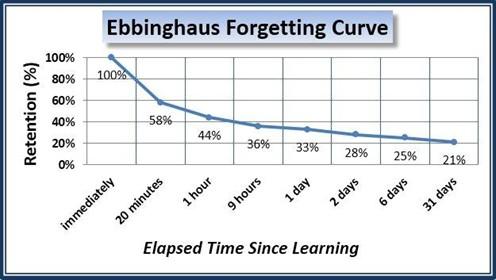
What’s more, the Ebbinghaus curve’s numbers are based on the assumption that the learned material :
On the curve, you can see that if you memorize information now and try to recall after 14 days, you will be able to retrieve about 21-23% of the previously memorized knowledge. Mind you that this is the knowledge that is incoherent, bears no emotional load and means nothing to you.
What happens when you start manually writing down words which interest you or when you are able to establish some connection between them and your life? Well, this number can definitely go up.
Keep in mind that your recall rate will also be affected by:
- frequency of occurrence
- prior vocabulary knowledge
- cognateness.
Since most advanced language learners have a benefit of possessing broader linguistic background knowledge, they can get away with using subpar learning strategies. Their long-term memory modulates short-term memory and thus decreases the overall cognitive load.
Nope. It follows very precisely the Ebbinghaus forgetting curve which takes into account your short-term memory. Sometimes this number will be higher, sometimes it will be lower depending on your choice of words.
You can check it yourself how low this number can get. Simply choose a language that is from a different linguistic family than the ones you already know. Track your progress and see how this number inevitably goes down.
The Goldlist Method is just a spaced repetition method with bigger intervals. That makes it less effective than most spaced repetition program right off the bat.
One of the most important concepts in productivity is the activation energy.
The activation energy is the amount of energy needed to start conducting a given activity.
Even though the Goldlist Method has initially the low activation energy, it starts growing considerably with each and every distillation. Having to carry with you a couple of A4 notebooks seems also very impractical to me.
However, the biggest problem I have with this method in this department is that it suggests I only learn words I am interested in. There are hundreds of situations where one has to learn words that they are not interested in.
Good learning methods should work for any kind of vocabulary.s
And they should work particularly well for the vocabulary you’re interested in.


Photo by Steve Johnson on Unsplash
This is one of the methods which collapse under their own weight i.e. it’s inflexible. The Goldlist method suggests that you learn vocabulary in 25-word batches.
If I need to master a language quickly and I want to learn at least 40-50 words per day? After 10 days I will be forced to go through 20 distillations. After one month this number will start hitting insane heights. More and more of my attention will be required to keep up with all the reviews. This seems very off-putting.
Another important quality of effective learning methods is that they should automate the learning process. The method which necessitates more and more conscious decisions on your part the more you want to learn simply doesn’t fit the bill.
The enormous red flag for any language learning method is the exclusion of context from the learning process.
Simply repeating information in a mindless manner is called passive rehearsal. Many years ago it was actually proven that passive rehearsal has little effect on whether or not information is later recalled from the long-term memory (Craik & Watkins, 1973).
This is just the first problem with the lack of context.
The other one is that almost all the knowledge you possess is activated contextually. If there is no context, it will be extremely difficult for you to retrieve a word when you need it.
In other words – you will remember the information but you will have a hard time using it in a conversation.
As a result, soon enough you will forget a word because there will be no network of other information holding it in your head.
The problem with the Goldlist Method is encapsulated in a famous adage used by Marines:
‘Train as you fight, fight as you train’
I can’t stress enough how important these words are.
Always try to train for reality in a manner that mimics the unpredictability and conditions of real life. Anything else than that is simply a filler. A waste of time. It gives you this warm feeling inside, “I have done my job for today”, but it doesn’t deliver results.
Tell me, is rewriting words from one notebook to another actually close to using your target language?
Another elementary mistake that we tend to make way too often when we fail to retain a word is actually not trying at all to memorize something.
You see, everything starts with a retention intention.
This fact is even reflected in the simplified model of acquiring information:
A retention intention sets the stage for good remembering. It is a conscious commitment to acquire a memory and a plan for holding on to it. As soon as you commit to a memory goal, attention locks on to what you want to remember.
This is how attention works—it serves the goal of the moment. And the stronger the motivation for the goal, the more laserlike attention becomes and the greater its memory benefits.
In other words, you can watch as many TV series and read as many books as you like. It will still have almost zero effect if you don’t try to memorize the things you don’t know. The same goes for the Goldlist method.
A key feature of a retention intention is the plan for holding on to the material. It might be as simple as rehearsing the memory, or it might involve one of the memory strategies described later. Whatever the plan, when you are clear about how you intend to retain the material, it is more likely you will actually carry out the plan, and this can make all the difference between a weak and strong memory.
Take a peek once again at the simplified model of acquiring information.
What you can see is that the second most important part of the process of memorization is encoding.
Encoding is any attempt to manipulate the information you are trying to memorize in order to remember it better.
Encoding can be further divided into shallow and deep encoding.
In the world of language learning, deep encoding is nothing more than creating sentences with the words you intend to memorize. In other words, it’s creating contexts for the items you want to learn.
Shadow encoding encompasses almost everything else. Counting vowels, writing down the said items and so on.
Deep encoding is the fastest and the most certain way of memorizing information and maximizing your chances of retrieving it.
If you skip encoding, like the GoldList method does, you immediately revert to mindless repetitions of words (i.e. passive rehearsal).
And we all know how it ends.
Mindless repetition of words has almost zero effect on your learning. If you want to increase your chances of memorizing them permanently you need to use the new words actively in a task (Laufer & Hulstijn (2001:14).
To be honest, I could add some more mistakes which this method perpetuates. However, I think enough is enough – I think I have pointed out all the most glaring ones.
Read more about factors affecting word difficulty i.e., what kills your learning progress.

There are two things I like about the Goldlist method
That’s it.
The Goldlist method is too flawed to fix it in a considerable manner but let me offer you this suggestion.
Instead of rewriting words, start building sentences with them for every distillation.
This way you will incorporate some deep encoding into your learning process. You should see the difference progress-wise almost immediately.
There is no point in beating around the bush – this is one of the worst learning methods I have ever encountered. It violates almost every major memory principle. If you were contemplating using it – just don’t.
If you have nothing against using apps and programs to learn, I would suggest you start your language learning journey with ANKI.
Here are two case studies which will show you how to do it
The Goldlist method is one of the best examples of something I have been saying for years – anyone can come up with a learning method. Sometimes it’s enough to sprinkle it with some scientific half-truths to convince thousands of people to try it.
My opinion is this – you’re much better off using many other methods. This is one of the few which seems to be violating almost all known memory principles.
Reading articles online is a great way to expand your knowledge. However, the sad thing is that after barely 1 day, we tend to forget most of the things we have read.
I am on the mission to change it. I have created 30 flashcards that you can download to truly learn information from this article. It’s enough to download ANKI, and you’re good to go.


I zealously advocate active language learning. This is definitely the most-effective and easily available remedy for frustratingly slow learning progress (read more about active learning here).
But advising you to only learn actively, or claiming that I do so, would be nothing more than denying our human nature.
Sometimes you are sick. Sometimes you feel down for no particular reason.
Sometimes, you would rather get wasted than learn.
That’s why you should accept that you won’t be able to learn actively all the time.
Not that you shouldn’t try, of course! It’s simply not sustainable for longer periods of time.
The perfect solution is to combine active and passive learning. But first things first.
We like to believe that the time we spend doing something is the main indicator of our progress.
It’s not. It’s the intensity of your training.
The more hard work you are able to condense into one hour of learning, the better.
That’s what makes active learning so highly efficient.
But there is just one problem.
The deep, active learning is tiring as hell.
Not time-consuming, mind you. Just energy-devouring. That’s why we love to avoid it.
We don’t want anyone meddling with our energy deposits.
“F*ck off brain, will ya?! I need my glucose to come up with sarcastic retorts to situations that will never happen”.
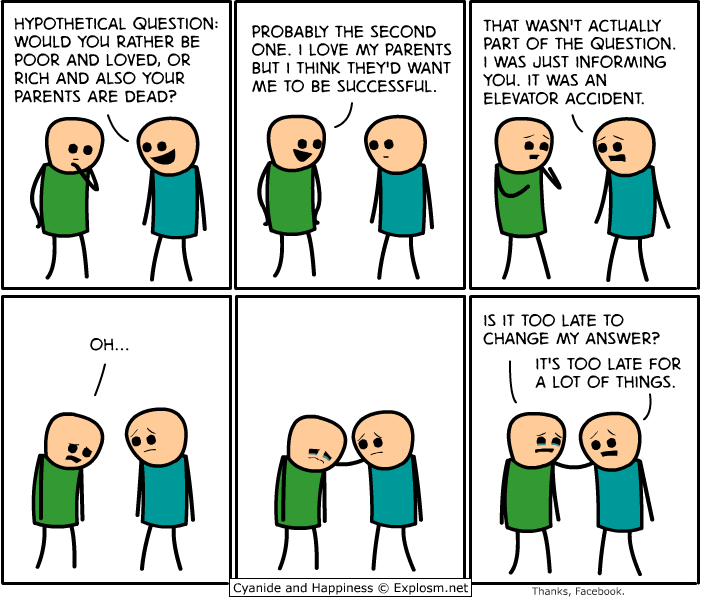
Simply find the time of the day when you are still energetic enough to do the hard work.
Always tired after work?
Wake up earlier and do the work.
Too sleepy in the morning?
Come back from, take a nap and do the work.
You get it. Just do the damn work.
Ok, so that one is clear.
So how does the passive learning fit into the “big picture?”
I will stress it one more time – active learning should be the foundation of your learning.
But the thing is that this foundation is never perfect.
It is scarred by cracks and blemishes.
But you can still smuggle quite a bit of sand between the cracks.

This is the role of passive learning – it should fill all the voids throughout your day and complete your learning.
After all, each day consists of a considerable amount of “dead-time”.
Like standing in a line or going for a walk.
Why not listen to some podcasts or music in your target language?
Of course, I am not suggesting that you go mental.
Don’t try to fill every moment of your day with some learning (unless you really want to!).
Remember that we all need some downtime to remember information better.
There are four categories of things you can optimize for language learning
“Optimizing” people sounds more than bad. I know.
But you talk to people anyway.
Why not find some language partners to talk to throughout the day?
After all, they are only a click away from you in this wireless era.
Here are some places to get you started:
– Facebook groups
– meetup.com
– Craig’s List
– Italki. com
– Hello Talk
Any place where you spend quite some time can be optimized for language learning.
Simple stick-it notes can transform any dusty desk into a learning battle station.
But don’t make them boring!. You know what I mean.
Don’t just write “desk = der Tisch” and stick it in its respective place.
Make it memorable. Make it fun!
Write “Ich lecke meinen Tisch, wenn ich blau bin” (I lick my desk when I am sloshed).
That’s something to remember!
Or even better – make yourself a poster while we’re at it.
Here is a quick example:

Even though you might not fully realize it, you use at least dozens of tools every day.
A fair share of them is electronic – search engines, mobile phones, browsers, Windows, Excel, etc. – you name it.
But why on Earth would you want to use them in your native tongue?!
Make a list of all the most important software / websites / etc. you use and change the language to your target language!
Our days are marked by myriads of repetitive activities – commuting, cleaning a flat, going to a gym.
Once again, this is something you might use to your advantage.
You can prepare a playlist beforehand and listen to your favorite bands / podcasts / videos during that time.
I hope that these ideas will set you on the right path.
Now, let’s take a look at how the hypothetical “optimized” day might look like!
You wake up at 7 am sharp.
Your alarm clock starts blaring.
Beep, beEP, BEEP!!!
“It’s another shitty today”, you think to yourself as you step into the bathroom.
You look at your comatose self in the mirror, sigh heavily, brush your teeth and try to shape yourself into something which resembles the human form.
Then breakfast, dull as Kristen Stewart’s acting, and you kiss your wife. Your eyes utter mute “help me” as you pass her by and leave.
Ugh! Boring!
But it could look like this:
Your alarm clock gently jars you out of sleep.
You open your eyes and light an entire room with your beaming smile.
No wonder.
This time you haven’t been ear-raped by some mechanical rattle.
No. This time you wake up to the sounds of your favorite song in your target language.
You graciously jump out of bed and leap towards the bathroom.
You look at yourself and think, “Gee, I really do look amazing today!”, as the next song in your target language starts playing.
You dig into your breakfast.
It tastes like a nectar made by Zeus himself.
What to do:
Prepare in advance the playlist of songs in your target language.
Delete all the other songs in your mother tongue.
Leave yourself no other choice but to listen to the language you want to improve.
Of course, if a part of your morning routine is to listen to the news or the radio, you don’t have to change it.
Find radio stations in your target language on my other website and simply listen to them instead.
You slowly drag your feet toward the train station. “It’s funny”, you notice. The pavement tiles strangely resemble your life. They are gray and shattered.

Once you take a sit, you try to pass the time by rating the miserableness of your co-passengers. But there are no winners in this game.
Pretty bad, right? But it could look like this:
You maniacally run towards your train station. You can’t wait to hop on the train! This is one of your favorite parts of the day.
You take a seat and fire off your favorite YT channel. The fascinating interview about … completely pulls you in. “Already my station?”, you think to yourself. “I completely lost track of time!”.
What to do:
Always have some resources handy on your mobile/tablet/notebook. Not too many of them – it leads to decision fatigue. Ideally, it should be something that really interests you.
You should aim at energizing yourself before you start work. If you wear yourself off mentally, you will send a signal to your brain to actually start avoiding this activity in the future.
Aim at interviews or some funny, easily digestible shows. Unless you are really into politics or some “heavier” topics – then go ahead and listen to them as well.
You enter the office and gaze absently at your coworkers.
Then you head toward the kitchen to fix yourself a cup of instant enthusiasm.
Not that it helps. It’s just a thing you do to pull yourself faster through the day.
All the breaks and conversations turn into one big blur.
Even some breaks in-between don’t deliver any relief.
Nightmare, ain’t it? But what about this:
You rush into a kitchen and pour yourself a delicious cup of caffeine goodness.
You sit comfortably in your cubicle.
Not an ordinary cubicle mind you but a language optimized cubicle.
All around you, there are stick-it notes with interesting quotes or jokes in your target language.
After you dig yourself up out of the weekend’s backlog, you start reading newspapers in your target language.
What to do:
It’s a very good habit to change the interface of every possible app or website you use to your target language. However don’t feel pressured to do so right away, If you are a beginner.
You might dip your toes first.
Write down where to change language settings and then switch interface to your target language.
Start translating any useful words you might need and switch the language back on.
After a couple of such sessions, you should be able to comfortably navigate through any website/app.
What’s more, you can always put some stick-it knows with useful phrases or quotes around you.
Why phrases or quotes?
Because learning is always more efficient when there is context.
Why only put a note on your plant called “plant”, when you can write “a green and beautiful plant!”.
Or “watering plants causes diarrhea”.
I know, I know – it sounds absolutely childish.
The thing is that the absurd information is absorbed more effectively.
So why don’t you help your brain a little bit?
Come-Back Home
That was one hell of the day!
You’re absolutely ecstatic! You finish your job, catch the train back and come back home.
You open the door to your flat and suddenly everything goes totally silent.
You know what you have to do now.
The damn work.


The quality of your life depends mostly on your ability to make the right decisions and to solve problems.
One could think that in the world of almost unlimited access to information our decision-making abilities should be getting better and better.
Is it really the case?
I don't think so. There are many explanations for why it is so.
However, instead of delving into them, I would like you to show you how to improve the quality of your thinking and problem-solving skills with the concept of my own devising - The Magnet Theory.
But first things first. Let's start with a structure of knowledge.
Not a week goes by when I hear someone say - if you don't understand something, don't learn it. And some part of me crumbles away every time when I hear it.
Why?
Because nothing could be further from the truth.
Understanding is very often the by-product of all the information at your disposal.
Let me explain why. Let's start with fundamentals i.e. Bloom's taxonomy.
Bloom's taxonomy depicts the structure of knowledge and how it is organized.
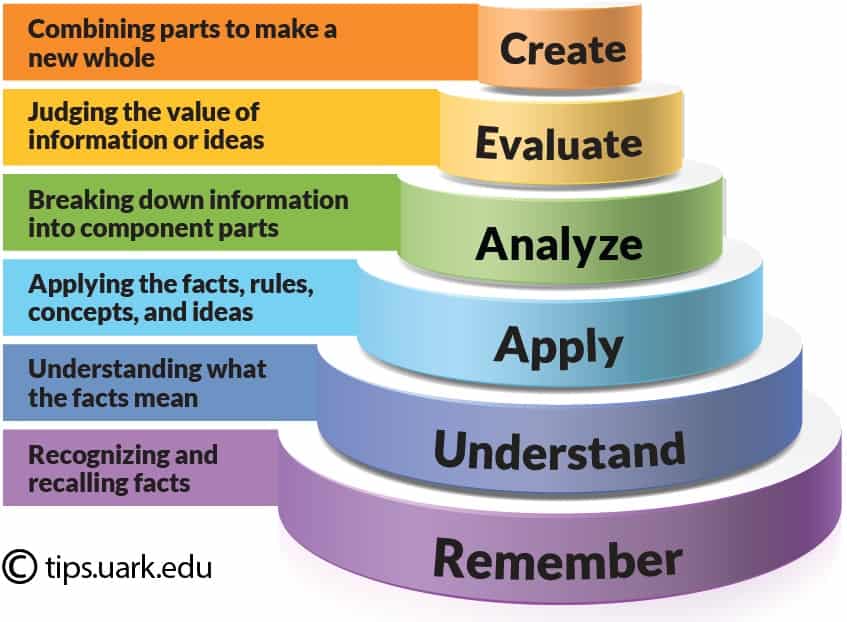
Take a look at the foundation of this pyramid. Can you see it? That's right. Understanding doesn't seem to be the most important element of knowledge.
Why do you think it is so? I will tell you why - because you can't think without facts.
Facts are frequently the foundation of good solutions and thinking.
My guess is that most of the time, on the surface, it is easier to understand something than to memorize dozens of different facts.
We like to assume that if A leads to D then it surely happens in a nice progression - A causes B. B causes C. C causes D.
The reality is that most of the time progression looks more like this.
A -> L -> B -> G -> C -> K -> X -> E -> D
It's an interaction of dozens of different elements which we very often don't see because of our limited knowledge. This phenomenon is called "The illusion of explanatory depth".
"People believe that they know way more than they actually do. What allows us to persist in this belief is other people. In the case of my toilet, someone else designed it so that I can operate it easily. This is something humans are very good at. We’ve been relying on one another’s expertise ever since we figured out how to hunt together, which was probably a key development in our evolutionary history. So well do we collaborate, Sloman and Fernbach argue, that we can hardly tell where our own understanding ends and others’ begins."
“This is how a community of knowledge can become dangerous,” Sloman and Fernbach observe.

As you probably know, your short-term memory is the bottleneck in the learning process. It can only accommodate a couple of pieces of information at the same time.
That doesn't inspire much confidence comprehension-wise, does it?
How many concepts do you know that can be understood by knowing just 3-5 facts? I can tell you right away, that there are not many of them. And even if you find any, they probably won't be worth your while.
In order to see the big picture, you need a lot of facts. Which, truth be told, can be problematic.
Why?
Because you don't know how many puzzle pieces are needed to create it. That leaves you just one choice - you have to keep on memorizing things even if they don't make any sense at the moment. You need to memorize facts before you understand what they mean.
If you memorize just the things you understand, you will never be able to look beyond the obvious. The problem nowadays is that almost nobody is willing to do it. Why bother if all the knowledge you need is at your fingertips?
This phenomenon is known as the Google effect or digital amnesia.
It is the tendency to forget information that can be found readily online by using Internet search engines such as Google. According to the first study about the Google effect, people are less likely to remember certain details they believe will be accessible online.
The thing is that if you want to be the best at something, you need all those pesky details.
Throughout the years of running this website, I have received tons of questions about my process of writing and thinking (e.g. The truth about the effectiveness and usefulness of mnemonics in learning).
My answer has always been the same and possibly disappointing to others - I try to memorize everything.
I don't care how abstract or vague a given piece of information seems. I will commit it to my memory.
I do it because I can't possibly know which fact will tip the scale and raise the curtain to reveal the magnificence of understanding.
That's why I can't be picky.
At some point, the facts always come together to form a clear answer. Sometimes, you just have to wait for it.
For example, right now I can tell you quite exactly what science currently has to say about the process of working-memory consolidation. This knowledge includes even tiny facts about frequencies of different brain waves.
And I will be honest with you. I don't know right now the purpose of this information. I am more than clueless. But I am pretty sure it will come handy one day. Maybe in one year, maybe in ten. Whenever it might be, I know that I will be ready.
It might not be the most pleasant way to acquire expertise. However, it's sure as hell the fastest and the most certain way to do it.

Years ago, I was obsessing over the question - how come two smart individuals can arrive at completely different conclusions?
I knew that asking good questions was important in that process. I also understood that you couldn't think effectively without facts.
The effect of these cogitations turned into something I dubbed The Magnet Theory.
It's a very elegant way of understanding the process of problem-solving and effective thinking.
Think of any question or problem you might have as a powerful magnet. The minute you encounter some riddle, the magnet starts doing its magic. It starts scouring your mind and attracting everything which might be useful in the process of cracking a given problem.
And I really do mean everything - anecdotes, scientific facts, your personal experiences and so on. The whole comes together and creates a solution to the problem.
There is one more component of the magnet theory - your ego. It filters and potentially distorts all the potential conclusions you may reach. Even if all the facts are in favor of one solution, your ego might nudge you to reject them all.
How many people do you know who don't have an opinion on some matter? Not many.
That's the thing. Any question you ask or problem you state is a potential magnet for the mind of your interlocutor. The magnet will scrape up every little bit piece of information. As a consequence, this motley clue of assorted facts and anecdotes will form an opinion on a given topic.
Are these opinions worth much? You can answer this question yourself.
Remember that you will always have an answer to almost every question. That doesn't mean that the answer you come up with is any good. As the great and late Richard Feynman used to say
The first principle is that you must not fool yourself – and you are the easiest person to fool.
Don't rush to the conclusions. Before you make a decision ask yourself this - how many good facts do I have at my disposal? Not opinions, not anecdotes but the cold scientific facts.
If the answer is "not many" then do your research to give your magnet some "better food".
I routinely distrust anyone and double-check any kind of information myself. Maybe I am paranoid but my behavior is driven by one simple question - how many people appreciate the importance of memorization and treat it as an indispensable part of their expertise acquisition?
The answer is - close to zero.
That automatically renders most of the opinions you will ever hear in your life invalid. Or at best they might be classified as half-truths. It sounds callous but it's definitely true.
Surveys on many other issues have yielded similarly dismaying results. “As a rule, strong feelings about issues do not emerge from deep understanding,” Sloman and Fernbach write. And here our dependence on other minds reinforces the problem. If your position on, say, the Affordable Care Act is baseless and I rely on it, then my opinion is also baseless. When I talk to Tom and he decides he agrees with me, his opinion is also baseless, but now that the three of us concur we feel that much more smug about our views. - Why Facts Don't Change Our Minds | The New Yorker
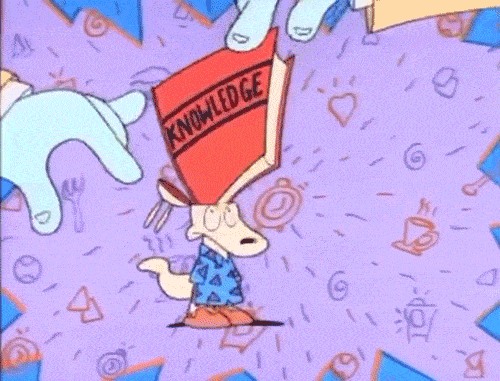
It's worth keeping in mind that the more somebody holds himself in high esteem, the slimmer the chances that they will be swayed by facts that contradict their opinions.
What's worse, everyone is affected by this bias. Especially all the people who think of themselves as experts or have fancy titles like a Ph.D. or a professor.
Alas, the titles don't mean diddly-squat if you don't have vast knowledge.
If I invited you to a blind taste test of a $12 wine versus a $1,200 wine, could you tell the difference? I bet you $20 you couldn’t. In 2001, Frederic Brochet, a researcher at the University of Bordeaux, ran a study that sent shock waves through the wine industry. Determined to understand how wine drinkers decided which wines they liked, he invited fifty-seven recognized experts to evaluate two wines: one red, one white.
After tasting the two wines, the experts described the red wine as intense, deep, and spicy—words commonly used to describe red wines. The white was described in equally standard terms: lively, fresh, and floral. But what none of these experts picked up on was that the two wines were exactly the same wine. Even more damning, the wines were actually both white wine—the “red wine” had been colored with food coloring. Think about that for a second. Fifty-seven wine experts couldn’t even tell they were drinking two identical wines. - I Will Teach You To Be Rich by Ramit Sethi
It reminds me of a great story. A couple of years ago, there was a lot of controversy in Poland around the man called Jerzy Zieba. What did he do, you might ask?
He wrote the book called "The Hidden Therapies - What your doctor won't tell you". It shook the medical world in Poland to the core as it exposed incompetence and rigidness of the Polish health care. In one of the chapters, he described wonderful qualities of Vitamin C which can be used among others to:
As a result, the real shitstorm ensued. He was publically flailed and tarred and feathered at the altar of science. There were literally thousands of medical professionals who mocked him to no end.
After all, he was not a doctor. So what that in his book he quoted hundreds of scientific studies from all over the world to back up his claims. He was no one and had no say in the matter.
I saw professors of medicine and oncologists saying straight to the camera that this is scientific tosh and they haven't seen even one scientific paper who proved it.
So why I am telling you all this?
Because each one of these detractors was dead wrong. There are actually hundreds of scientific studies proving the efficacy of vitamin C in treating almost every possible malady.
This anecdote is especially important for me because I have been personally interested in medicine for a long time now as it's definitely one of the main fields of knowledge where you are only as good as your memory. Throughout the years I have read, gathered and memorized dozens upon dozens of articles and studies about vitamin C which confirm its effectiveness.
In the end, the professors were wrong. The ego got the best of them.
It's an important reminder for all of us to never get too cocky. In other words - be humble or be humbled.
Let's ponder over the following problem. Let's say that your aunt Elma wants to lose weight.
She has been buying Vanity Fair for a long time, so she knows that even though she accepts herself, she is fat and hideous, and needs to slim down.
The years of reading have equipped her with a truly powerful, intellectual toolkit.
She knows that she has to:
Is losing weight really that simple?
It might seem so. After all, doing all those things takes us from point A to point B.
Before, I move on. ask yourself the same question. Be sure to follow the whirlwind of incoming thoughts.
Can you feel how they are trying to organize themselves? Or do you maybe feel like you have a ready answer?
I can bet that your first instinct is to start spewing out all the facts in your head. I know that it is typically my first reaction.
However, what's on the surface might be merely a tip of the iceberg. But only once you take a peek "under the hood", will you be able to see the real complexity of the issue at hand.
Of course, it would be just the beginning of your investigative journey. Next, you would have to learn what is responsible for each of these functions.
Only then will you be able to truly understand what is required to lose weight.
And it would be a truly amazing journey because the truth is that there are thousands of possible solutions. If you dig long enough, I am sure you will be able to find the optimal one.
I don't mean to make you paranoid. Of course, you don't have to possess a profound understanding of everything. Although I would suggest you do it for every area of knowledge which is of interest to you.
The Magnet Theory is an easy way to understand how the processes of thinking and problem-solving work. It can be summarized in the following way:
The theory leaves us with three conclusions that are applicable to every area of life.
There you have it. I hope that you will be able to apply this theory to improve your quality of thinking.
Do you have anecdotes where some tiny piece of information helped you understand something? Please let me know in the comments.
Reading articles online is a great way to expand your knowledge. However, the sad thing is that after barely 1 day, we tend to forget most of the things we have read.
I am on the mission to change it. I have created over 12 flashcards that you can download to truly learn information from this article. It’s enough to download ANKI, and you’re good to go. This way, you will be able to speed up your learning in a more impactful way.


Learning on your own can be quite an unsettling experience, especially initially. Instead of being guided by a helpful hand of a coach or trainer, you cling to a clammy hand of doubt and despair. Questions like "What if I am wrong?", "Am I consolidating all the wrong things right now" become your bread and butter. To minimize the amount of all those unpleasantries, you need to learn how to self-assess your progress.
Sadly, choosing the right method to do it can be also confusing. After all, there are lots of ways to do it! No strategy is universal enough as to work for everyone. That's why I suggest that you spend some time thinking about the right way to assess your progress. If you don't do this, it will be challenging to tell whether you're pushing forward at the optimal pace or just spinning your wheels.
A fantastic feature of every SRS program, including my all-time favorite ANKI, is that every flashcard is a form of self-quiz. It provides you with immediate feedback about your knowledge.
It's like a virtual friend that regularly hangs out with you to make sure you have mastered your area of choice. You can't lose long-term with buddies like that!
We're getting a little meta here, but trying to evaluate somebody's performance, for example via teaching, is an excellent gauge of your current progress.
You see, it's very difficult to be able to single out somebody's mistakes unless you're on the same or a higher level than this person. Thus, doing so is a meta confirmation that you've achieved a certain level.
Of course, you don't have to teach someone to be able to benefit from this strategy. It can be as easy as observing somebody's performance on video. Or you can simply try to criticize somebody's work "theoretically".
For example, let's say that your goal is to create amazing facial creams. In that case, you can pick up any cream of one of your potential competitors and try to find flaws in it. At the same time, you can also try to find positives to consolidate your knowledge further.


Photo by Steve Halama on Unsplash
Comparing your performance against other learners can tell you volumes about your current skill set or expertise. There is nothing more telling than seeing where you fall within a given group.
Interviews are a great form of a comparison between you and, often, hundreds of other candidates. Even if you're not looking currently for a job, it's still worth applying for one to test yourself.
If you fail, you will still get feedback from a company, and thus you will learn where you fell short. Heck, failing in itself, is a form of feedback.
If you succeed, you can ask for detailed feedback concerning your performance. Even if you turn the job down, you will still learn a lot.
Competing with others is probably almost as old as our entire civilization and is still as popular as ever. Find a relevant competition that involves your skillset and see how you fare against other candidates.
An important benefit of this assessment method is that you also test how well you cope with pressure. Of course, it doesn't make much sense if your skill is performed in isolation. However, in all other cases, it's necessary to get out of the comfort zone to get a realistic picture of our expertise.
Online tests can provide you with relatively precise and, more importantly, almost immediate feedback. In the era of the internet, finding one that is relevant to your field shouldn't be too challenging.
The only thing you should keep in mind is choosing the test of high quality. You need a test that can provide you with meaningful information. Sometimes, it simply means paying a couple of bucks.
Certificates are one of the best ways to get very detailed feedback about your performance. It's not only a benchmark to measure your knowledge against - it can actually be something you can strive for. A source of inspiration if you will. If you want a meaningful confirmation that you've learned the material or skill effectively, look no further.
In some cases, your goal is to create some masterpiece. It can be a program, a flying machine, a flamethrower, and whatnot. Creating the said item will allow you to assess your expertise critically.


It's important to ask yourself these questions because if you just mindlessly keep on producing these items, you won't be able to improve. At least not by a significant margin.
You can use my experience as a case study. I have been composing for lots of years now with a plan for publishing my work in the future. You can call it my long-term side project. Whenever I finish an outline of a song, I send it to a group of my friends, asking them for a review.
The group is selected based on one criterion — they are honest. If something is shit, it's shit, and there are no two ways about it. This isn't where the process ends.
To further maximize the usefulness and truthfulness of this feedback, I ask my friends to share it with one or two other people. These may be family members or just close friends.
Some of them listen to other genres of music, and some don't listen to music at all. Once I get all the reviews and comments, I paste them into an Excel file and analyze them.
A bit unorthodox way of composing, but it certainly helps to yank me out of the echo chamber in which many creators live in. It's very sobering sometimes to hear, "man, just delete this song."
Checklists have been widely popular for at least a couple of decades now. It's hard to find even an averagely organized company that doesn't use it to some degree. And there are good reasons for that - they make the overwhelming manageable.
Of course, checklists are amazing at all levels of advancement, but they are especially useful for beginners. First of all, they allow you to decrease your cognitive load drastically. They are the life-ring that stops you from drowning in the excessive amount of information. One look and you know what should be done.
However, the most important benefit for independent learners is that they enable you to efficiently self-assess your progress. Upon performing a given activity, you can quickly consult such a list to see what was done right and where you fell short.
Videotaping yourself is a form of formative assessment since it allows you to assess your performance during instruction (i.e., performance).
Recording yourself on video is an amazingly simple and effective way to identify areas that you need to improve. Of course, it's not for everyone, and it won't apply to some areas of knowledge. However, it's a perfect feedback mechanism for musicians, actors, speakers, performers, and dancers.
The research certainly supports this way of learning:
Developing musicians typically engage in self-regulated practicing during the time that passes between lessons with their teachers. An important aspect of self-regulated practice is the ability to identify and correct areas of development in performance in the absence of a teacher’s feedback, but the effort required to perform as well as monitor a performance represents a challenge for any learner.
Videotaping the performance and watching it afterward to fully concentrate on each task could constitute a solution to this problem. In our study, we verified how video feedback could affect the self-evaluation of intermediate-advanced musicians while practicing a new piece of music.
To attain this objective, we analyzed and coded the self-evaluative comments of 16 classical guitarists while practicing. We then compared the number of coding entries in each category of a group of participants who used video feedback (n = 8) on four occasions over a period of ten practice sessions with those of a group of musicians who did not use video feedback (n = 8).
Our results indicate that musicians who used video feedback modified the way they formulated their self-evaluative comments while practicing and that these changes were more marked with higher-performing musicians. [[source]]
Knowing how to self-assess your progress as an independent learner is one of the most important keys to your success. Without that skill, you are bound to forever stray in the cognitive darkness or worse, beg for crumbles of advice from others' mouths.
Keep in mind that your feedback mechanism will heavily depend on what resources you have and your area of choice. It's also one of those cases where more is better. It's certainly preferable, especially if you want to be independent, to rely on more than one of the strategies above. Even if you can't pick a perfect feedback mechanism, you can incorporate smaller feedback drills to ensure you're not entirely without feedback.
Reading articles online is a great way to expand your knowledge. However, the sad thing is that after barely 1 day, we tend to forget most of the things we have read.
I am on the mission to change it. I have created over 14 flashcards that you can download to truly learn information from this article. It’s enough to download ANKI, and you’re good to go. This way, you will be able to speed up your learning in a more impactful way.


Even though much has been written about how to use passive learning, i.e. reading and listening, in language learning, many language learners still puzzle over the following question, "How can I leverage it in order to speed up my learning progress?"
This question is extremely important because the way you combine passive and active learning is actually the key to learning a language fluently.


One of the most frequent claims in the language learning community is that passive learning (i.e. reading and listening) is very helpful with memorizing new vocabulary.
Is it true?
The answer is, surprisingly, yes and no. It simply depends on your current language level.
If we take a look at the scientific literature, we can learn that there are two important milestones concerning your ability to learn from the context:
When is passive learning useful for memorization?
3000 words allow you to understand about 95% of most ordinary texts (Hazenberg and Hulstijn, 1996). It seems like a lot.
Sure, on this level, you will be able to hold a decent conversation. You will also be able to get the general ideas and concepts of most of the articles.
This milestone is also important because it's so-called the minimal threshold for passive learning. It means that reading and listening start making sense only at this level (read more about how many words you need to know for every language level).
5000 words allow you to understand about 98% of most ordinary texts (Nation (1990) and Laufer (1997)).
Such a vocabulary size warrants also accurate contextual guessing (Coady et al., 1993; Hirsh & Nation, 1992; Laufer, 1997).
For exactly that reason this milestone is called the optimal threshold for passive learning.
What's more, the body of research shows that you need to repeat a piece of information (unintentionally) between 20 and 50 times in order to put it into your long-term memory (i.e. be able to activate it without any conscious effort).
As a sidenote, my personal experience is this - even 5000 words are not enough to start memorizing words. You should aim for at least 8000 in order to do it efficiently.
The conclusion from the above is simple.
Passive learning can be an effective tool for memorization when you know at least 5000 words. But it doesn't mean that reading or listening is useless before that.
In order to understand well the function of passive learning in the learning process, we need to start at the source - the simple model of memorization.
This sexy model tells us that in order to acquire knowledge quickly and efficiently, you need to encode information. In other words, you need to manipulate the information in a meaningful way.
Is the element of encoding present in passive learning (i.e. reading or listening)?
Of course not!
That's the reason why active learning is much better suited for learning material fast.
However, the problem with active learning is that it's tiring as hell even though it doesn't take a lot of time. At the end of your learning session, you should feel as if you have been mauled and teabagged by a bear at the same time.
It's not pretty.
What it tells us is that you can do learn actively only for the limited period of time before you run out of steam. In other words, active learning is not sustainable long-term.
What happens then? Do you just call it a day? Nope. You switch to passive learning.
active learning + passive learning = optimal learning
If you stick to this formula, you are guaranteed to learn relatively fast.
Always push yourself to the limit while learning actively and when you are about to black out switch to passive learning.
Of course, this isn't the only benefit of reading and listening.


Before I move on, let's clarify what priming is.
Priming is a technique whereby exposure to one stimulus influences a response to a subsequent stimulus, without conscious guidance or intention.
Linguistic priming is one of the main factors that influence the accessibility of information in memory (read more about why it is difficult to recall words and how to fix it). The activation of stored knowledge through experiences in the immediate context can make prime-relevant information more accessible in memory, and such recent construct activation can influence inferences, evaluations, and decisions on subsequent tasks. - The SAGE Handbook of Social Psychology: Concise Student Edition
In other words, priming can provide for sets of actions, or, in the lexical field, sets of words.
So, for example, a listener, hearing the word bread will recognize words like baker, butter, knife more quickly than unrelated words like a doctor, mortar, radiator.
One of the prime researchers in this field, Hoey, states: (...) Priming is the result of a speaker encountering evidence and generalising from it. [Primings come] from single focussed and generalising encounters. Language teaching materials and language teachers can provide essential shortcuts to primings. (Hoey 2005: 185f.)
Now that you know what priming is, it's time to take a look how it affects our memory.
There is one main effect of priming on our memory.
We process frequent collocations faster than infrequent ones.
In other words, it's much easier for us, foreign language learners, to understand speech which consists of logical and frequently ocurring collocations. It's much easier to process a sentence like "I am cutting an onion with a knife" than "I am cutting an onion with a German Shepherd".
How is it possible?
Because our memories are organized into something called "schemas".
"Schema'' is used as a general term to cover all kinds of general knowledge. More closely specified versions of schemas are called scripts, which consist of general knowledge about particular kinds of events, or frames, which consist of knowledge about the properties of particular objects or locations.
It means that with every new collocation e.g. "cut with a knife", "a sharp knife", "stab with a knife", your time of reaction when it comes to understand gets decreased.
If your scripts are rich enough, you can actually predict, even though it's mostly imperceptible for us, what somebody is going to say (read more about how we process speech here).
What's fascinating, auditory word priming does not require access to word meaning, it may reflect the process whereby listeners build and use presemantic auditory representations. (Trofimovich 2005: 482)
What is a likely mechanism supporting spoken-word processing and learning?
I will tell you a little bit more practical consequences of this phenomenon later.
Priming can take many different forms and shapes. One which you might find really interesting is syntactic priming.
Syntactic priming is the phenomenon in which participants adopt the linguistic behaviour of their partner.
Yes. The more time you spend with somebody, the more likely it is that you will understand this person's idiolect (or that you will adapt it).
Idiolect is an individual's distinctive and unique use of language, including speech.
Referring to their earlier (1981) work, Ratcliff and McKoon (1988: 389) point out that “they have shown that priming can be obtained between concepts that are much more than four words apart.”
They (and others) therefore raise an important issue about collocation, since it appears to contradict Sinclair’s (1991) claim that there are no valid collocations beyond the five-word mark on either side. The concept of lexical access appears to be very close to lexical priming.
De Mornay Davies is more explicit when he states: Even if two words are not ‘semantically related’ in the strictest sense (i.e. they do not come from the same superordinate category), their frequent association produces a relationship at the “meaning” level. (de Mornay Davies 1998: 394). Source: The concept of Lexical Priming in the context of language use, Michael Pace-Sigge
As you can see, priming is a truly powerful weapon as it relates to concepts which are not in their direct proximity.
What it means practically is that your brain will still be able to understand a collocation even if you interject an extra thought into a sentence.
Here is an example of this phenomenon: "I wanted to cook a dinner, so I started to cut an onion, you know, with, like, a really sharp knife".
Findings suggest that auditory word-priming effects have a long-term memory component and are long-lasting (Trofimovich 2005: 481).
What does it mean that they are long-lasting?
It's speculated that these effects can last months or even years.


Speaking fluently is a really tricky thing.
Why?
Because you have to combine two things. First of all, you need to actively memorize new words, ideally, by creating a new context for them.
That will see the said words in your memory. The problem is that, as I have said before, unless you have a lot of contexts, you won't be able to recall them fast.
Is the solution creating a lot of sentences for a given word?
Sure, it will work, but it's too much consuming. However, if you start learning passively, you will be exposed to dozens of different contexts for almost every possible word you know.
Even though, you won't feel it, these contexts will be generalized in your head into scripts and will start acting as triggers.
From then on, whenever you run into a situation which fits your script, your primed words will be right there at the top of your tongue.
If you have ever struggled with fluent speaking, I can guarantee you that you're missing one of these puzzle pieces.
Keep in mind that the richer your words of associations for a given word, the easier it is to understand it.
Reading and, especially, listening are amazing learning tools which will expand this network relatively effortlessly.
Passive learning is certainly a misunderstood language learning tool. Even though it's often touted as a great tool for memorization, it's actually pretty ineffective in this department unless you are already an advanced learner. Its real power lies in creating an extensive network of contexts and connections which allow you to both recall and understand words much faster.
Reading articles online is a great way to expand your knowledge. However, the sad thing is that after barely 1 day, we tend to forget most of the things we have read.
I am on the mission to change it. I have created over 16 flashcards that you can download to truly learn information from this article. It’s enough to download ANKI, and you’re good to go. This way, you will be able to speed up your learning in a more impactful way.


It's a safe bet that you have heard about short-term memory (a.k.a. working memory).
But have you ever considered it a potential source of problems with knowledge acquisition?
Personally, it took me a long time to see it that way. We all know and have heard about not multitasking and about avoiding distractions when we try to do something productive.
But as it turns out these are merely a part of the bigger picture. But first thing is first - capacity of working memory is often described using Miller's number. Basically, it means that you can memorize 7 (give or take 2) bits of information.
What's more the duration of short-term memory seems to be anything from 20 seconds up to 40-50 minutes, depending on the kind of information and the way of encoding?
Let's try to imagine a process of memorization in some picturesque way.
A funnel might be the capacity of our working memory, while donuts are bits of information we want to absorb. Let's say that the information is stored when a donut passes through the neck of the funnel.
So what might go wrong?
In other words - what decreases the capacity of working memory? Well-known culprits are:
We all have met some guy (once or twice) who say "I swear man, I can pull a couple of all-nighters without any problem" But then you look at him and it turns out that he's having a feverish conversation with a chair.
Depending on the study, a week of sleeping 4-5 hours per night seems to be an equivalent to a blood alcohol level of 0.1%. In the meantime, your brain burns through the sugar stored in your body making you crave all the sugary goodies.
Did I mention that the first parts of the brain which fall victim to sleep deprivation are the ones responsible for higher order thinking? Because who really needs abstract thinking when you barely stand on your feet!
Remedy: try to get at least seven hours of sleep per night
Shortly - many studies have proved that exercise stimulates new brain cell growth, increases connections between cells, and improves attention span.
Remedy: run fatty, run!
Your brain is a powerful and formidable machine which needs its fuel to function properly. And let's be honest - you know that McDonald won't cut it.
Remedy: in order to keep your brain well-oiled and ensure the formation of new brain cells feed your brain with proteins, Omega-3 fatty acids, vitamin B, folate, zinc and drink much water.
Stress triggers the Flight-or-Fight response. As a result, your body releases hormones like adrenalin or cortisol.
You know the feeling - your heart rate increases, your hands get all sweaty, you feel the surge of anxiety mixed with energy. And the thing is that, of course, such a reaction is completely natural. The problem appears when you face chronic stress.
As a result, you may fall victim to obesity, depression, ulcers, sexual dysfunction.
Remedy: all work and no play makes Jack a dull boy. Remember to do something to unwind every day. Get a massage, play with your kids, feed the pigeons - whatever floats your boat.


In today's world, it's considered normal to multitask at work or at home. Many people take great pride in doing many things at the same time, or in switching from one task to another. It saddens me greatly.
Cognitive costs of such a behavior are really huge. That's not a big deal when you don't work on anything productive at the moment. But if you really want to be productive and achieve some goal, you should learn how to focus on just one thing in any given moment.
Such an approach helps to tune out all the distractions and get the most out of your time. And don't be one of those people who say "BS, I know how to multitask productively". You can't.
Remedy: turn off your mobile-phone! Buy ear-plugs (this is my method) and find some quiet place to work on your project(s).
Trying to stuff 20 or 50 donuts through the narrow neck of the funnel would be plain crazy. Logic tells us that we should do something to widen the neck of the funnel.
So how can we do it?
Well, there are temporary solutions like medication and electrical brain stimulations but I guess they are a bit risky. More permanent solutions cover two things:
Let me quote you results from one of the latest studies concerning working memory (it can be found here):
Crystallized intelligence (Gc) is thought to reflect skills acquired through knowledge and experience and is related to verbal ability, language development1, and academic success. [...] While previous studies have indicated that gains in intelligence are due to improvements in test-taking skills, this study demonstrates that it is possible to improve crystallized skills through working memory training.
Such a training concentrates mainly on mnemonics. It is important to know that memory uses them to trigger various physiological responses.
Depending on the techniques you use, mnemonics might include tastes, touch, emotions (fear, love, anxiety, pleasure), images, sounds, etc. All together they help you to remember better.
What's more, since all the images created with help of mnemonics are placed in different locations, it's much easier to "widen" the neck of our donut funnel and increase the amount of information you acquire.


The second method which can help us with widening the neck of the donut funnel is called "chunking". The essence of this method is to break up strings of information into units, or chunks if you will. It simplifies such a string and makes it easier to memorize.
Example:
424862365935636235861
It seems impossible to memorize it quickly. But let's try to slice this string into smaller 3-digit strings.
424 862 365 935 636 235 861
Now let's imagine that these numbers express how far you were able to throw a rotten herring. You started with a decent throw of 424 m then it got better. And so on.
If you are a sports fan you might try to use 4-digit chunks and treat them as the time needed to run a 400 m. Be creative and come with some other way of breaking up this string!
The main takeaway is that you can improve your working memory by either unburdening it or by training it. As always - it's not easy and takes dedication. But once you take the first step in the right direction it gets only better.
Think ahead and imagine how much you can change and achieve in your life if you only improve your memory. And don't put it off. Choose the first strategy which you want to implement and start using it!.
I'll leave with a great talk about working memory. Enjoy!


"Just keep on talking" has to be one of the most worn-out phrases in the world of language learning.
Can't learn a language? Talk.
Not making enough progress? You're not talking enough. After all, a road to the mount fluency is paved with endless hours of conversation.
"But my progress has really stalled and ... ." MOOOOOOOOOOOOORE, you moron!
Sounds familiar? I bet it does.
If you are one of those people who at some point got stuck at the "intermediate plateau" this article is for you.
Although speaking is without any doubt very effective language learning tool, it's not the optimal solution for every language learner.
What's more, this advice can be actually detrimental to your learning
Let's deconstruct this piece of advice so you understand where the rub lies!
As always, let's start with basics.
Here is the general overview of the number of words and the level of understanding they warrant (for more information read how many words you should know for every language level)
1000 words (A2) | 1000 words allow you to understand about 80% of the language which surrounds you, as long as they are not fancy. |
3000 words (B1/B2) | 3000 words allow you to understand about 95% of most ordinary texts (Hazenberg and Hulstijn, 1996). |
5000 words (B2) | 5000 words allow you to understand about 98% of most ordinary texts (Nation (1990) and Laufer (1997)). Such a vocabulary size warrants also accurate contextual guessing (Coady et al., 1993; Hirsh & Nation, 1992; Laufer, 1997). |
10000 words (C1 / C2) | 10000 words allow you to understand about 99% of most texts (Nation (1990) and Laufer (1997)). |
Depending on a choice of words, you can deduct or add 20% of a given number.
Keep those numbers in mind. We will come back to them soon.
But for now, since nobody like party-poopers. let's concentrate on positive aspects of speaking.


Speaking is certainly a GREAT idea, if not the best one, if you start learning a language.
Before I get to "why", let's look at other options.
Reading? Useless. Let's be honest - what can you read at this point that has any deeper meaning or sense and resonates with you? "Judy likes potatoes. She eats potatoes. Potatoes are sweet and tasty".
Ugh, shoot me in the face already.
Listening? Mostly useless. You don't know enough words anyway to make head nor tail out of the constant stream of speech. "Dfsdfsdfs "I" ........(wall of noise) ..." says" .......... "hide the body".
Speaking? Yes, please! In every possible amount.
Not reading, not listening - speaking is one of the best things you can do at the beginning of your learning.
Why?
It's breath-taking how complicated it is to utter even one correctish sentence. There are so many things to remember! The best thing about speaking is that it helps you integrate ALL of them.
And so on.
It can be as simple as uttering short sentences over and over again. You don't need to talk with anyone really. You can just talk to yourself.
What's more. Your sentences don't have to be correct every time. It's enough that your language partner understands what you mean.
Last but not least, the main rule which contributes to the rapid learning is using your knowledge actively.
So it happens that speaking is the pinnacle of active language use.
Of course, you can choose to ignore active learning but I can tell you right now what will happen:
So do yourself a favor and start talking as quickly as you can. Remember. You don't have to talk to others. You can just start with uttering short sentences under your breath.


Nothing good lasts forever. Speaking has also its expiration date efficiency-wise.
So when does the fun-ride end? Around a B2 mark (i.e. 4000 / 5000 words.).
Why?
There are two very important reasons for that.
By this level, you should have your basic grammar fluency. You have produced enough sentences to automate dozens of different grammar patterns and constructions. Uttering more sentences won't bring you much closer to your goal of being fully fluent.
At this point, you need to expand your vocabulary more in order to achieve your goal.
Remember previously mentioned numbers? They will come handy now.
We established that knowing about 5 k words grants us the understanding of about 98% of all the things we hear on a daily basis.
What this number is trying to tell us is this:
If you just talk and don't challenge yourself, you repeat things you already know 95-98% of the time.
Let me rephrase it - out of every 100 words you use only about 2-5 of them can be considered learning.
Even better! Think about like this.
Out of every hour, you only practise for 36 seconds to 3 minutes.
Let's go crazy and say that it is 5 minutes.
How would you react if your buddy told you about a friend of his who is a little bit "special". Jeff works as a car dealer and every day he calls the same 95 people, who already bought a car, to sell them the very same car.
I guess you would imagine that he is the kind of guy who gets his pay in sugar cubes and wears a bib instead of a tie. That's how special he is.
Don't be like Jeff.
Of course, if your goal is to learn just one language or have a lot of time, keep at it.
However, for any other goal, I would suggest you start fixing your learning schedule.
There is a simple rule for that.
If you can already spend an hour or two talking without finding blood stains under your armpits and seeing black blobs in the corner of your eyes it means you're not learning anymore.
You're just repeating the same ol' things over and over again and most of your time and effort is wasted.
I am willing to bet that you already know it deep inside. Try to tune your ears to conversations you typically have in your target language. Aren't you using the same phrases all the time?
If yes, you need to step it up and stop wasting time on lessons that don't contribute much to your language development.
The higher your level, the bigger the problem.
It's worth noting that the more advanced you get, the bigger the said problem becomes.
At a C1 level, you know about 99 % of all the words that can be encountered in everyday conversations. Speaking more is clearly not an effective solution here.


Before I move on, keep in mind that all the advice in this article aims at improving your learning effectiveness regardless of whether you are learning on your own or by having privates lessons or language exchanges.
By no means am I suggesting that you should cut off your friends and leave them high and dry just because this kind of talking is not the most effective learning option out there.
"Sorry Suzie, this random dude on the internet helped me realize that you're wasting my time. Good riddance and farewell!".
If you are talking to your friends on a daily basis, there is no reason to give it up. You will learn something every day anyway.
Now that we've gotten this hurdle out of the way, let me repeat again - If you want to get out of this gruesome rut and fix your language learning schedule, you need to concentrate on words/phrases you don't know well.
There are a couple of ways to do it, but they all share one feature.
"Give me six hours to chop down a tree and I will spend the first four sharpening the axe." - Abraham Lincoln
Making the best use out of your lesson is all about the proper preparation.
As a rule of thumb, I recommend most people at a B2 level or higher to put in 4-5 hours of preparation before each lesson.
Of course, if you learn on your own, feel free to use those techniques whenever your heart desires.
If you use structured lessons, usually there is some subject or article that will be discussed. In that case, always make sure that you discuss it with yourself or your friends in advance.
Here is a great website with over 100 topics and thousands of questions which you might use to test yourself.
Remember - if you catch yourself not knowing some word, always write it down and learn it.
Think about words like "bodkin", "grovel" or "coppice". Most people don't use them that often in their native tongues, let alone in their target language.
That's why you always should have a system in place to master such words. Otherwise, they quickly fall into oblivion.
As always I recommend ANKI as your go-to program for learning new vocab.


While discussing a given subject beforehand is a foolproof method to quickly discover gaps in your knowledge, there is a method that's much quicker - open a dictionary.
After all, there are potentially thousands of words there which you don't know and use. Pick the ones you find useful, learn them and start using them during your next language learning session.
And don't worry too much about using them incorrectly. If it happens, your teacher/language partner will quickly correct your mistake. Not a big deal, right?
Another good idea, although much more time-consuming compared to the previous ones is to simply read a lot about a subject you're going to discuss during your next lesson.
Find 5-10 articles and start slogging through them!
Your brain is wired to use the most efficient neural pathways i.e. the words you already know very well. That's why you need to put conscious effort into avoiding them.
It can be as simple as writing down a couple of new phrases on a piece of paper as a reminder of what you can say instead. That's why Thesaurus is going to be your new best friend.
For example
"I think" = "I believe"
"She cried" = "She was crying her eyes out"
Read more about the word substitution technique - how to increase your vocabulary size considerably.
Why change a subject every 2-3 days? By discussing the same subject for a longer period of time, you will be able to activate your topical vocabulary much better and understand it much deeper.
Speaking is not the ultimate remedy for all your language problems. While it's a great strategy at the beginning of your language journey, it gets progressively less effective the more advanced you become.
If you hope to keep on progressing fast, you need to start using some strategies for activating less frequent vocabulary. Once you incorporate them into your language learning schedule, you should see a huge difference.
Agree? Disagree? Let me know!
Reading articles online is a great way to expand your knowledge. However, the sad thing is that after barely 1 day, we tend to forget most of the things we have read.
I am on the mission to change it. I have created over 19 flashcards that you can download to truly learn information from this article. It’s enough to download ANKI, and you’re good to go. This way, you will be able to speed up your learning in a more impactful way.